#my favorite thing? creating strong female characters who could be the protagonist of their own series <3
Text
if i were to ever get back into b.n.ha, it’d be just to bring back my knucklehead of a hero student who would 100% be best friends with hyouka ( who would have to get a verse ofc ) after knocking heads for a good minute. i miss writing a smug bastard who can actually back up all her boasting :’ ))))) she was the type to talk big and try very hard to come off as cool ( and instead it’s just cheesy and annoying asdfg ) and it was honestly very very fun to write!
#my favorite thing? creating strong female characters who could be the protagonist of their own series <3#ngl i wasn't a fan of the rpc at the time i was part of it#but i'd bring back one miss hekima and maybe her pal#that ofc would open a gateway into the network of characters i created to all kinda connect but who doesn't enjoy connected oc's???#i say as though i don't have a million characters on my roster already ANYWAY enough getting distracted!!#i just miss my little heroes and i've been tempted to pick up bnha again after going to awa this past weekend#now that i've said it aloud i can put a pin in it for now!#get ready to ramble | ooc
2 notes
·
View notes
Text
Things Get Better?: LGBTQ Representation in Animation in 2022 [Part 1]
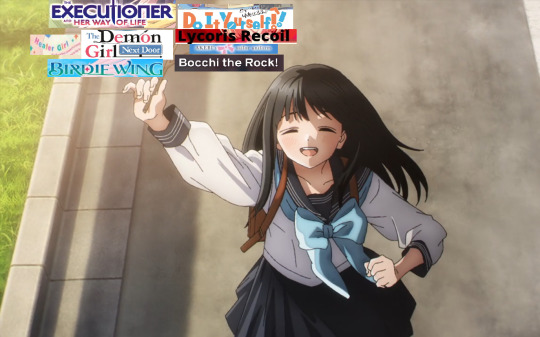
Komichi Akebi of Akebi's Sailor Uniform happily welcomes all the LGBTQ animated shows in this article. Logos of my favorite anime with LGBTQ themes which aired throughout 2022 are shown in this graphic which I created
In January 2022, I wrote that there was a possibility that in 2022 things would "get better" in terms of LGBTQ representation, with new fandoms developing from shows which take risks by telling diverse stories. Although 2022, in some regards, more than lived up to this possibility and went beyond, there were challenges.
Reprinted from Pop Culture Maniacs and Wayback Machine. This was the nineteenth article I wrote for Pop Culture Maniacs. This post was originally published on January 16, 2023.
In the world of anime, some series with implied, or directly represented, LGBTQ characters, came to an end. [1] Often times these series had yuri themes. For instance, there were somewhat strong undertones between the protagonist, Komichi Akebi, and her friend, Erika Kizaki, in Akebi's Sailor Uniform, and the protagonists of The Demon Girl Next Door, Yuko Yoshida and Momo Chiyoda, and those of the short-lived, but intriguing, yuri isekai, The Executioner and Her Way of Life. In the latter series, one of the protagonists, Akari Tokitō, has a crush on Menou, a female assassin with a duty to kill her. At the same time, Menou's aide, Momo, has a crush on her and is jealous of how close she is getting to Akari.
One series, Birdie Wing: Golf Girls' Story, blew representation out of the water, with strong romantic themes between Eve and a Japanese girl she plays golf against, Aoi Amawashi. Eve is often unaware of how romantic she is toward Aoi, who has a clear crush on her. Erica Friedman of Okazu, a well-known reviewer who focuses on lesbian themes in anime, even wrote that she may "start measuring other anime based on how amazing this one was". Other series ranged from having implied to more direct themes, including Vampire in the Garden, Do it Yourself!!, Bocchi the Rock!, Healer Girl, Lycoris Recoil, and Mobile Suit Gundam: The Witch from Mercury.
There were additional anime with LGBTQ themes or characters. For instance, Life with an Ordinary Guy who Reincarnated into a Total Fantasy Knockout, which had a three month run from January to March 2022, featured a reincarnated protagonist, Hinata Tachibana, who is heavily implied to be a bisexual trans woman. The spinoff from the popular Rooster Teeth series, RWBY, named RWBY: Ice Queendom, featured a non-binary nightmare hunter, Shion Zaiden. Christine Brent, Senior Brand Director for Rooster Teeth, confirmed this and said she would like to have similar characters in future productions.
Apart from these series, there were implied yuri themes in the ongoing idol series Love Live! Superstar!! and second season of Love Live! Nijigasaki High School Idol Club. Such themes were also present in Management of Novice Alchemist, Encouragement of Climb: Next Summit, KanColle: Itsuka Ano Umi de, My Master Has No Tail, Prima Doll, Smile of the Arsnotoria the Animation, Shine Post, and many others, [2] all of which began, and ended, in 2022.
Many of these series are on Crunchyroll, one of the biggest anime streaming services. With its recent merger with Funimation, Crunchyroll now dominates the anime streaming market, and will likely continue crackdowns on pirate sites. Its only real competition is YouTube, smaller sites like HIDIVE (owned by AMC), and streaming services such as Netflix, Tubi, and Hulu.
© 2022-2023 Burkely Hermann. All rights reserved.
Notes
[1] Some could say that the final season of Princess Connect! Re:Dive has yuri subtext and point to the second season of Dota: Dragon's Blood featuring an Elven thief named Fymrym, who was once in a polyamorous relationship with a woman and two men, with her partners murdered by Luna, who attacks the Elves who don't worship Selemene. Also, Komi Can't Communicate featured Najimi Osana who has an ambiguous gender and Ren Yamai who is a lesbian, a bisexual man named Apollo in Is It Wrong to Try to Pick Up Girls in a Dungeon?, gay characters like Nagi and Soldier in Goblins Cave and Suma in Demon Slayer: Kimetsu no Yaiba. Attack on Titan has LGBTQ characters as well, as does One Piece.
[2] Others, as listed on Yuri Anime Reviews, include Teppen!!!!!!!!!!!!!!! Laughing ‘Til You Cry, League of Nations Air Force Aviation Magic Band Luminous Witches, Kakegurui Twin, Magia Record: Puella Magi Madoka Magica Side Story Final Season, RPG Real Estate, Miss Shachiku and the Little Baby Ghost, Black Rock Shooter: Dawn Fall, Cue!, Slow Loop, and Girls' Frontline.
#lgbtq#animation#anime#akebi's sailor uniform#komichi akebi#akebi chan no sailor fuku#the executioner and her way of life#the demon girl next door#machikado mazoku#birdie wing#yuri#rwby#rwby ice queendom#rooster teeth#crunchyroll#hidive
25 notes
·
View notes
Text
By Your Hands and the Art of Subversion
Hello everyone! It's been commonplace for people to talk about "subversive narratives" and how their favorite shows subvert tropes often considered dated and tired. But what does that mean? Why are people obsessed with "subversive media"? The TV Tropes definition of a "subversion" is when the story sets up a well-known trope the audience would expect in that work's genre and then goes in a different direction, going against the audience's assumptions of what would happen. At least that's the intention. Subversion has been used in many different ways from Doki Doki Literature Club pretending to be a romance novel before revealing itself to being a horror VN to the tutorial in Undertale turning out to try to kill you. And it's been used as a storytelling tool since Shakespeare. Used effectively, subversion can be used to make a good story more enthralling and exciting. But subversion can also fall apart. It depends a lot on the context surrounding the time the work was released in, so if you don't know the context, it becomes meaningless. For example, it was shocking to see Samus Aran from the original Metroid turn out to be a sexy woman if you beat the game fast enough since female protagonists were a rare sight in 80s video games. But if the game was released today, the reaction wouldn't be nearly as strong because it wouldn't be unusual for a modern audience.
So where does By Your Hands come in? I touched on this in my "The Making of By Your Hands" but BYH was created as a response to other FVNs. It takes the audience's expectations of certain FVNs and their tropes and subverts them to (hopefully) create something unique. This game was created with the intention that the audience is well-versed with FVNs beforehand. Now unfortunately I can't tell you the full extent of how the game uses subversion because that would spoil things that aren't in the game. I'll just talk about the non-spoiler stuff. By Your Hands is specifically a subversion of the contemporary college-setting furry dating sim that's seen in VNs like Extracurricular Activities and After Class. It also takes some cues from Psychological Horror FVNs that could be read as a response to those tropes, although in a very subtle manner that won't be apparent until we reach the end of the game. It was envisioned so that the intended audience of the game (avid FVN readers) would be caught off guard by how the plot and characters played with the tropes that were made standard in other FVNs of its genre.
To go in-depth, you'd expect Tucker to be this dumb, himbo-y character who likes sports a lot based on other tiger characters from these types of FVNs. I mean the two tiger FVN characters I think of first are Torahiko from Morenatsu and Lin Hu from Nekojishi, both of them are these nice, muscular, kinda ditzy, childhood sweethearts to the MC. Then he starts to speak. And it becomes obvious that he's not your typical FVN tiger character. The protagonist doesn't have preferences or hobbies because he's always been in a controlled environment before he goes to college. The childhood friend confesses that he's in love with you as soon as he can and gets rejected if you aren't on his route. The athletic best friend is more submissive and doesn't go head-first into every situation. The hot teacher constantly reminds you of the boundaries that a teacher and student should maintain and he's also a History teacher instead of an English teacher. The dark, brooding love interest isn't a muscular, macho dude in a tank top but a goth twunk who loves drag. And the characters who are a tiger, wolf, and lion respectively do not have their own routes. In fact, the tiger dies at the game's inciting incident. And so on and so forth. The game uses subversion of common FVN tropes in order to make a setting that's wholly unique.
Now initially I was hesitant about making this game a "subversion" of these slice-of-life dating sims. The first is that I didn't want to create a "slice of life game for people who don't like slice of life" and have people think that I hate slice of life. Indeed, By Your Hands is mostly a Mystery but it's also slice of life as well. I didn't want to gain an audience who'd diss slice of life and not consider it a worthwhile genre. It's one reason why there's a group of people who really hate DDLC, because it uses the dating sim aspect as a framing device for the actual plot rather than as a way to do interesting things with the genre and that's not at all what I wanted to do. A more ideal work that subverts genre expectations would be Invincible. It subverts superhero tropes and archetypes but it never outright disrespects the genre and it manages to take the genre to places it wouldn't have if it stuck with all the genre conventions. So even though BYH does subvert and commentate on tropes common to furry slice of life dating sims, it doesn't say that they're stupid and you're an idiot for liking them. I love slice of life and I wouldn't mind seeing more of them. It just showcases what a slice-of-life FVN would be like if that story beats and characters went a little differently.
I also didn't want to call it a subversion because when people see a work call themselves a "subversive story", they think they don't know what they're talking about and that they're only using those words because it makes the work sound really cool. Marketing-wise, having your hook be "A subversion of the slice of life FVN" sounds really stupid, so I'm not doing that. However, I think calling BYH a "subversion" in devlogs, discord servers, and basically anything that's not trying to market the game would be fine. My audience knows I believe that's what BYH is and if they disagree, it's no big deal. And I didn't want to show a lack of understanding of the genre by subverting a trope…that's not common in any FVN, slice of life or not.
But why a subversion of this specific genre? What prompted this idea? Well, when you have a community of people who are making and reading a particular thing, tropes and archetypes start to form. Soon people in the community will get attached to using those same tropes and archetypes and that's when things start to stagnate. When this happens, you can do two things. You can create something completely new with the genre, but then you risk of alienating the existing audience, going back to the "slice of life for those who don't like slice of life" concept I mentioned and most people aren't awesome enough to achieve that. The other thing you can do is make a response to those tropes and the works that helped cement them in the form of a story. You can use those same cliches but spin them around to explore something new. That's how we got works like Watchmen, Neon Genesis Evangelion, South Park, and Nier: Automata (as well as the rest of the Drakenguard series). I'm not saying that By Your Hands is as good as those works in general but what I'm saying is that I feel we need FVNs that are responses to the conventions of the genre they're in. We're seeing responses to Echo with VNs like Burrows going out of their way to give the player more agency in what they're doing, unlike the VN that came before it. With By Your Hands, the goal here is to show the flaws of a typical slice-of-life furry dating sim and see how the genre can do better in regard to character arcs and the setting. I'd like for the general FVN community to make better and more refreshing VNs. It would kinda suck if this scene stagnated to death. You can still enjoy your standard fare of FVNs but it's overall better if individual genres were able to expand their horizons. That's why By Your Hands and other VNs use subversion in their narrative, so they can push the limits of the genre and see its full potential.
I hope you enjoyed reading this. Have a good day and see you later!
2 notes
·
View notes
Note
Hihihi this is may be a weird question but is your opinion on the main hypmic cast?
In brief:
(Spoiler alert: It was not brief. Stuck under a cut for length)
Ichirou: He's a good kid. I wasn’t super into him at first, as main protagonists very rarely hold my interest, but I appreciate him now for the struggles he goes through and the growth he’s experienced across the series.
Jirou: Jirou is also a good kid in his own way. I didn’t know what to do with him for a while, but now I feel like I understand him too. I don’t think he quite gets what makes Ichirou be as loved as he is, nor does he really understand what makes people love him for who he is. But that’s okay. He’ll get it someday.
Saburou: If you had tasked me as a fourteen year old to create an idealized anime boy sona, I would have come up with someone shockingly similar to Saburou. I’m fond of him. He can be a bit mean at times in a very fourteen way, but deep down, he’s a good kid too. All the BBs are good kids.
Samatoki: I just can’t not make fun of him. His posturing is so ridiculous to me that I am constantly filled with the urge to clown on him. Oh, you think you’re so tough? You think you’re a big tough guy? Well, I’m just a little bastard; what are you going to do about it? But underneath the posturing, I do feel sorry for him and admire his strengths a lot. He’s a good kid too under a very funny exterior.
Juuto: I’m enjoying learning more about him from the BB/MTC+ manga, but I’m a bit surprised at how much of a dick he is even deep down. Still, he has plenty of good qualities too, and I like him in a vague sort of way. I’d throw fruit at him over a fence but wouldn’t put any malice in it.
Riou: What a delightful individual he is. The BB/MTC chapter about him really resonated with me. For a character so outwardly obsessed with the military, Riou has an incredible understanding of the weight of his actions and such a deep appreciation for every living thing. There’s a lot of his depth to his simplicity, and the level of care he exhibits towards everyone is delightful to witness. An absolute favorite among the cast.
Ramuda: Self-recognition through the other (derogatory). In all seriousness, Ramuda’s story arc and actions are great narrative tools for me to examine some things about myself and grow to try to be a better, more considerate person towards myself and others. I want to see him achieve freedom and happiness.
Gentarou: I enjoy Gentarou quite a bit, although I think he gets overshadowed by the other members of Fling Posse at times due to my sheer passion for Dice and Ramuda. He’s my favorite character to translate at the moment, which is apparently heresy among Hypmic translators. More than the sheer fun of writing his witty banter, I find him to be a very intriguing individual, and I’m excited to learn more about him. I want his happiness too.
Dice: Oh, Dice... He’s a really good kid in a way that the BBs could never be. He’s deceptively good, and he does choose to hurt other people and himself in ways that characters like Ichirou don’t. But he also finds the goodness in the oddest places, like a person finding a coin in a cracked sidewalk, and that’s delightful. His narrative is one of the most compelling for me. What a champion of a character.
Jakurai: Wow, what a good foil for Ramuda. Let me bounce narratives off of you like a mirror. I’m slowly learning to find him compelling in his own right, however. This is also a self-recognition through the other (derogatory) scenario, but there’s more of an emphasis on the derogatory part.
Hifumi: A funny little individual bearing a lot of sadness and a whole lot more courage. Like most of Matenrou, I admire him a lot, but I think that Matenrou resonates much more strongly with other people than they do for me, so I prefer to sit back and let other people appreciate them. I think he’s very brave and very fun to read/write.
Doppo: The biggest fucking mood in existence. When you move past the stereotypical aspects, you end up with another character who has a lot of deep flaws but also an incredible amount of courage. I’m excited to see where they go with him, but again, I’ll sit back and let others take the first row here.
Kuukou: Having already drafted Saburou, if you came back to me at age eighteen and asked me to make an idealized anime boy sona, you would probably have ended up with a character astonishingly like Kuukou. He brings me sheer joy. Astonishingly, I feel like Kuukou has exhibited the least growth out of any of the cast, and yet I do not mind a bit. He is the closest to the perfect man I have ever met. I would drop everything to be this dude’s homie if he existed in real life. Just a champion individual.
Juushi: Juushi’s a good kid. I’m very fond of him and like writing him, but much like Matenrou, I feel like he does a lot more for other people than he does for me. Therefore, much of how I work with him is less, “How do I enjoy this character as a reader?” and more “How do I nurture the traits about him that other people love?”
Hitoya: Hitoya strikes me as a damn good person with a lot of heart who sometimes lets his anger drive him a bit too much. He’s also utterly ridiculous, of course, but I try to write him with as much strength as possible to be present behind his words. He honestly seems like a great person to know in real life, not simply as a fictional character, as well.
Sasara: I have to clown on him to assert dominance. Joking aside, I admire the depths of his character and the growth he’s shown over the series. He can be pretty callous at times and goes to odd lengths to get what he wants, but I think he’s now starting to realize how much his actions affect other people. For a while I was really in his camp as a hardcore Sasara lover (back before he was a main cast member - I love writing quirky minor characters), but now I approach him with the idea mentioned above, ie how I can present him for other people.
Roshou: Whenever he’s around the rest of Dotsu Hon, I think he’s kind of an idiot. I mean that in the best way possible. It’s very endearing. Yet moments when he’s on his own are where I think he best shines, and I would love to see more solo material for him. He’s an incredibly good support character, and I admire his passion for his students.
Rei: I really enjoy asshole antagonists, which is why I liked Ramuda for a while before the clone story came up behind me and struck me into the ground with its mighty fists. Now Rei fills this role. I would love to learn more about him and team up with the Buster Bros to pelt him with rotten eggs in a fun bonding activity. I’m sure there is some strong backstory that will absolve him of at least some of his shittiness, but until now, I’m still not excusing his whole abandoning his children thing, not to mention the human trafficking thing he pulled with Ramuda.
Otome: I hate translating her, if only because she and Rei frequently talk about things in extremely vague terms that I have no context for. It’s hard to make her sound idiomatic in English while also not shooting myself in the foot by accidentally filling in the wrong information. But with that aside, she’s okay. I like her, I guess. Her motivations are pretty interesting.
Ichijiku: Ichijiku was written for people who are sexually attracted to women, and I’m not at all, so I 100% approach her in terms of her pull on other people. She’s fun on her own, though, and I’m impressed at her ability to walk in high heels. Her complete disrespect for everyone but Otome brings me no end of entertainment in reading and writing.
Nemu: YOU. Maybe this is some stupid toxic masculinity thing, but I always feel embarrassed speaking affectionately about male characters but not at all about female characters. Therefore Nemu gets all of my loveposting. She’s a wonderful girl! She has such a strong spirit, and I’m completely overjoyed that she’s making her own decisions and becoming her own character defined on her own terms. I want to watch her grow up big and strong. Fuck yes, baby girl! Fuck it up! I’m very proud of her.
166 notes
·
View notes
Text
The True Mighty Bison - Season V edition.
Some weeks ago, I had a very productive discussion on twitter with Steven Mane about the subject of this essay, and he brought up very good points, an alternative theory (not as out there as mine) and reminded me I haven't actually added the ACTUAL Seth info from his story and Arcade endings to this text. Now that even Rose is on the game (although she didn't bring new info on this front), Let's update this very wild theory about our favorite psycho powered dictator.
For the day you discovered the truth about M. Bison was the most important of your Street Fighter fan life. But for them, it was only Tuesday.
HEAVY SPOILERS FOR SETH'S SFV STORY MODE AND ENDING. and in a lesser intensity, Rose's.
-----------------------------------------------------------------------------
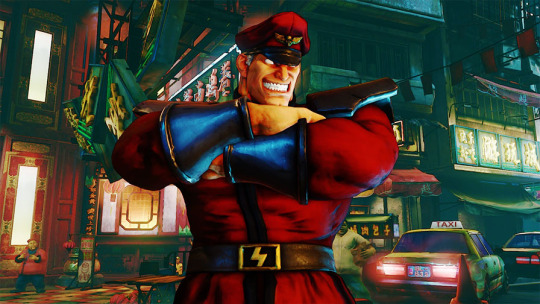
This is M. Bison. Bison is one first class A-hole who runs the biggest crime syndicate on the world (Shadaloo), wants to spark global destruction if not given global domination and has a tendency to kidnap 16 year old girls.
Bison also wields something called Psycho Power. Through profane rituals (more of this in a bit), He is the biggest source/receptacle of it. this power is also destroying his body, which leads to the only thing he likes more than kidnapping 16 year old girls: Body Swapping. The body in the picture is not his original body, not even his first, but is the... model we are most used to see him using. This is how you would imagine him if one mentioned M. Bison. In SFV he finally got grey/white hair, but originally this body had black hair.

however...
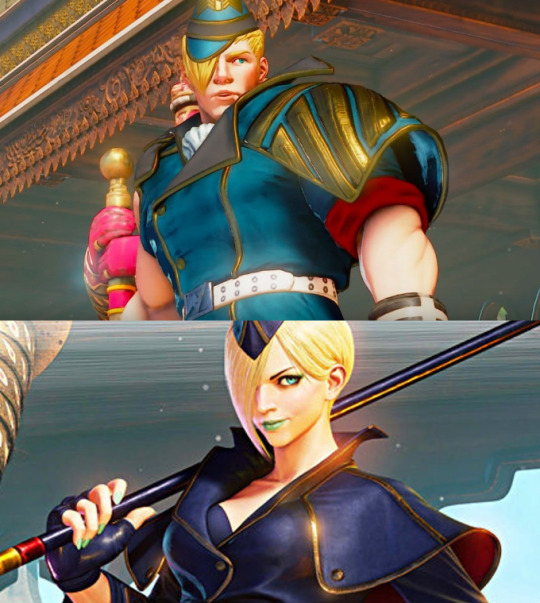
These are Ed and Falke. They are CLONED Bodies of Bison, They are both spare bodies for M. Bison, created in a attempt to build a body strong enough to hold his power. They are both of the most recent attempt, the newer models so to speak. As far as we know, they are all biological (a point that will come up later) and since CAPCOM use the word CLONES, they share the same DNA as Bison. Physically speaking, they are around their late teens, although being much younger actually (both suffered from accelerated aging). They escaped Shadaloo due to the fact that an older model ended up destroying the base where they were being held.
speaking of the Devil....
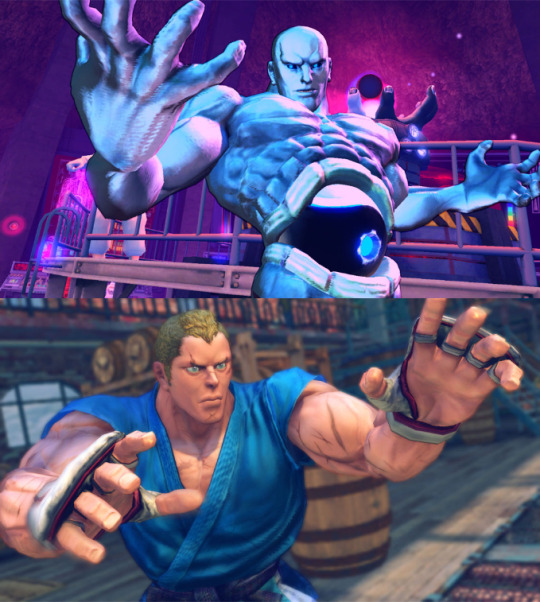
These are Seth and Abel. Also, spare bodies of Bison. But (un)fortunately, they developed a conscience and independence. While Abel ran away and joined the french army, Seth created a splinter cell from Shadaloo called S.I.N. and planned a hostile takeover of the syndicate. One interesting fact is that both Seth and Abel are the SAME MODEL of bodies, but Seth installed the upgrade of the Tanden Engine on his body. So Seth was once like Abel and if given enough time and the proper modifications, Abel could become like Seth.
One recent release on Street Fighter V revealed the Seth was always more machine than man. If that is plainly due the Tanden Engine modification and what this means to Abel, its still unknown. both (Abel more than Seth) still have Bison’s DNA on them.
Also, Bison considers this batch of clones a FAILED experiment
Seth was the final Boss of Street Fighter IV, and Abel was the protagonist of that series.
but, the older models are the more interesting ones.
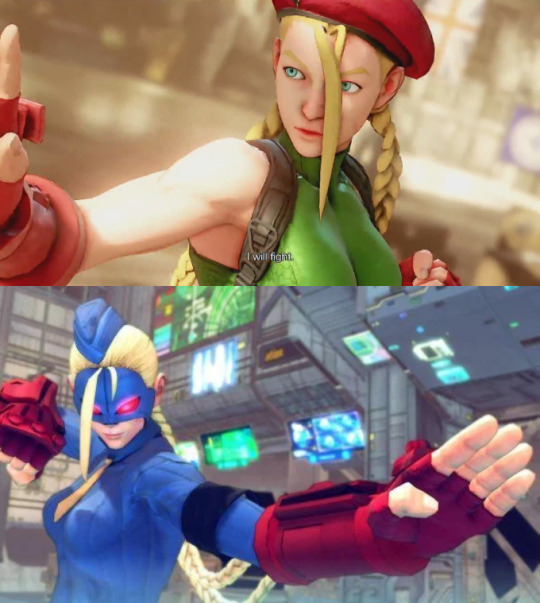
These are Cammy and Decapre. Both are the oldest clone models player knew until recently. They are also fully biological and the first successful vessels for Psycho Power. Decapre is actually a “ Cammy Alpha“, a first attempt to create Cammy herself. Being fully biological, they ALSO carry Bison’s DNA. While Cammy became independent and joined the British Army, Decapre stayed brainwashed and a weapon for Shadaloo until recently (SFIV). Both Decapre and Cammy were part of a shadaloo project call “The Dolls project“: Most of the Dolls were the kidnapped teenage girls mentioned before, who were also test beds for Bison’s mind control via psycho power. There were 12 Dolls (Decapre and other 11), with Cammy being a 13th, codenamed Killer Bee.
As of now, you probably noticed: 3 males, 3 females. We might be onto something here. But remember that profane ritual I mentioned? One of the results was this lady here...
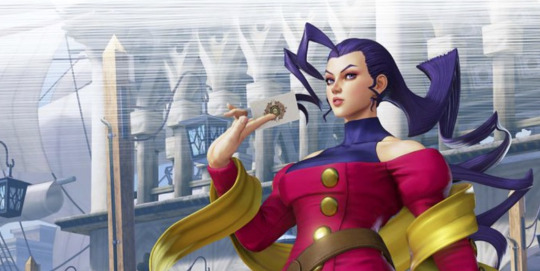
This is Rose. In order to get full access to Psycho Power, Bison had to EXPEL ALL THE GOOD ENERGY FROM HIS SOUL. No joking. the good half of Bison’s Soul incarnated on a young Italian GIRL who was being born that moment and who grew up to be a incredible psychic and fortune teller ,plus the most powerful user of the SOUL POWER, the opposite to Bison’s Psycho Power. so Rose is the REINCARNATION of Bison’s soul, or at least half of it. After the events of SF Alpha 3, Bison even used Rose’s body as a vessel, to hide himself from the authorities. How she was freed and what happened to her during SFII is still unknown. Street Fighter V didn't really expanded on the relationship between Rose and Bison, as much as confirmed that as of the end of A Shadow Falls (SFV general story mode), Bison's is truly gone, at least as definitive as Rose can sense.
Let's also remember that, until the interference of Rose herself, Cammy/Killer Bee was considered a succesfull attempt at creating the perfect body. If Rose hadn't freed Cammy's mind, which was as close to a blank slate and receptive as possible, its highly probable that Bison would be using her body instead.
Still with me? STREET FIGHTER V: ARCADE EDITION added another point on this list: SETH was released in 2020 as a playable character, part of Season IV. HOWEVER, the FORM he appeared is quite the surprise.

THIS IS SETH! YES, THAT SAME SETH!! (a name tag on SFV confirms this is number 15, the seth that was at the center of SFIV events) After having all of his bodies destroyed during SFIV, his brain was placed by Juri on an old body known as DOLL UNIT 0. The interesting thing here is that Jury is doing this in behalf of a third party, identified only as voice on phone. This voice expected a male body, while Juri didn't even noticed (or cared) that Seth or DU0's had a gender. Doll Unit 0's body accepted Seth's biological brain without a problem.
Seth's mind however, is on turmoil. When integrating with the DU0' original personality, something went wrong and Seth went completely batshit crazy. He only sees Psycho Power, and mistook Ed and Falke as being Bison himself, due to their Psycho Power energy. Some lines, such as this Seth is true perfection hints on a ongoing attempt of accepting the new body. The Arcade mode ending and an extra Seth on his Critical Art during his V-trigger 1 also hints that Seth's true power lies in the INTEGRATION with this new body.
ALL OF THESE, ALL OF IT, are just canon facts from the SF series lore.
now for the speculation.
Bison is not using the original body. And psycho power, specially the levels Bison desires, requires quite the strong one, which factors on why his current body is failing these days. why he had to abandon his original body? My only guess is that the profane ritual either destroyed it in the process or damaged it beyond repair. but at this point, Bison already had gained the power to posses other bodies.
Doll Unit 0, the prototype for the perfect vessel, is female. Bison’s soul incarnated on a female body and until very recently, when his clone technology developed enough to create more radical deviations, the clones were all female. While there is several attempts of male bodies they are a late development and not only there is only one almost successful male body, it is the one that requires constant replacing AND Bison is trying to upgrade from, because it's not enough. But, the creation of a male body is stiil on the table and being attempted.
Considering CAPCOM’s own words, that Seth is more machine than man, we can guess that Abel is probably just the biological basis for Seth, who is mostly the Tanden Engine and a biological brain. This is what was implemented into Doll Unit 0, who was completely female at that point, maybe even fully biological since Cammy, the earliest successful clone so far is fully biological as well.
If we compare to real world cloning technology, cloning someone of the same gender is easier and more direct than altering the gender. Then there is the not-satated-but-extremely-obvious-fact that DU0 was the true first attempt at the tech that would produce Cammy, meaning, Shadaloo’s cloning tech was tested with HER. This also means that Doll Unit 0 IS EXTREMELY SIMILAR, IF NOT IDENTICAL, TO BISON'S ORIGINAL BODY.
in conclusion: Bison’s original body is FEMALE and something close to this:
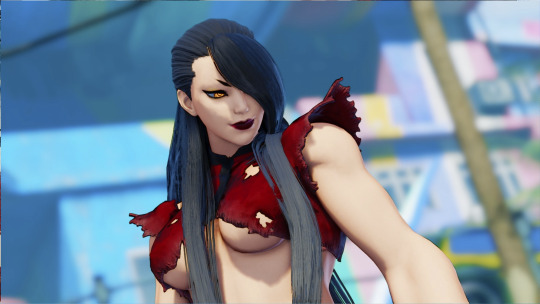
Thanks BbbSFXT from Deviant Art for the Mod and the picture.
On the last version, I considered Mistress Bison being blonde, but thinking it through, it was more wishful thinking, trying to make them close to Cammy.
Clones being a blonde is probably a side effect of DNA manipulation. Blond hair is recessive, and putting on the simplest, almost insulting way possible, it means blonde only happens if both sides of the DNA have the same code for hair. Since Bison is using the same DNA over and over, it makes sense clones would end up blonde. This also fits with DU0 being a very early prototype, with almost Bison's entire DNA intact, including the code for them hair.
And now let's talk mysticism: There is the whole Yin/Yang theme surround everything Psycho Power, explicitly shown in Seth's design, but it was already there, at least as early as the Alpha/Zero series. In the balance of the Yin/Yang symbolism, Yin, the black part, can represent a “feminine principle” and also, can be a suffix/preffix meaning shadow. While Yang, the white part, can represent a “masculine principle” and also can be a suffix/preffix meaning light. these are parts in all living beings, be them male or female.
Psycho Power, the shadow, is feminine. Soul Power, the light, is masculine. There is a inversion of the symbolism here, with Bison, the male body, using the yin and Rose, the female body, using the yang. But the catch is: Rose is not a traditional reincarnation of Bison (obvious reasons) but received Bison's yang, on top of her natural one. This counts on why Rose is so powerful with Soul power. And while she doesn't seem to suffer a physical instability like Bison, as fortune teller and psychic, seem to be incredibly sensitive to strong emotions and energies around her (How the mind of G affected her on SFV being a exemple), I would argue that this extreme sensitiveness is the side effect of that extra yang energy. Let's also consider that while Bison wants MORE shadow and went way beyond what his natural body could hold, Rose stayed pretty much at her natural levels, as far as we know.
So Bison's instability can be accounted as using insane levels of pure feminine energy inside a male body. Seth, the genderless one, will only find harmony in accepting his female body. Rose, the female body, is the only of them to have any kind of control and estability.
This all points towards Mistress Bison, and that's the hill I'm dying on.
this also ties to the idea proposed by Steven Mane: Psycho Power is closely related to the feminine and can't function properly, or at all, with men. Bison forcing that is the base reason for the physical instability. Which leads us to...
------------------------------------------------------------------------------
Steven Mane's alternative theory of Psycho Power
The main gist here is that there isn't really any indication that Bison's OG body is any different from the one he uses today (which is true. There isn't a single line about it on the canon sources). The initial lack of male clones is accounted simply as that we haven't seen enough male clones, and they might have existed since Killer Bee's times.
In his views, everything so far points to Bison desiring a male body. However, Psycho power works better with women, or was meant to be used by women. There is another fighting game with a similar plot, Skullgirls, in which the main McGuffin for that story is a mystical artifact that only works with women, which is why most of the cast of that game is female. And after Rose's SFV ending, I wouldn't put behind CAPCOM to lift another game's plot point for their own, specially one that would fit well with the already stablished canon. However, Steven Mane's best argument for this comes from SFA3 itself, or rather, the PSP version of SFA3.
But before we get to that, let's go down on the memory lane and remember the facts.
Street Fighter Alpha 3 MAX, also known as Street Fighter Zero 3 Double Upper in Japan, is so far the last version of Street Fighter Alpha 3 released and it is an exclusive of the Playstation Portable console. The Alpha/Zero Series is the main focal point when talking about Bison and Psycho Power, as it's the series where Rose first appeared and in Alpha 3, we have the only canon appearance of Cammy as Killer Bee (on the intro of her first fight against Rose) and the first playable Dolls, Juli and Juni.
SFA3 MAX is also, up to the publication of this, the only game in the series to have a guest character (the jury is still out on SFV last season V character). "Wait, Tony" you ask "Don't you mean 4 guest characters?" Eagle and Maki are not guests: They were always part of the Street Fighter franchise, and are contemporary to the events of the game . Yun makes a non-canon appearance which is explained by time travel (in his own quotes), since the events of Alpha series happen way when he was nothing but a toddler. But he is still part of the franchise, so not a guest, per se.
Ingrid, however, is a conundrum wrapped inside a enigma and kept inside a locked puzzle box missing some of its pieces. That is inside a cave inside a volcano under the pacific ocean. On the mariana trenches.
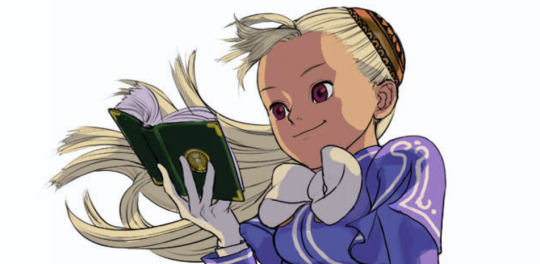
Ingrid is from a failed, unreleased CAPCOM game called CAPCOM Fighting All-Stars. Her first playable appearance is the ill-received crossover game CAPCOM Fighting Jam, known in Japan as CAPCOM Fighting Evolution.
In All-Stars, she was kind of a regular fighter, with a special importance to the plot and final boss. The very little we know about the plot hints on her being something beyond human. She carried a code Isis, is nicknamed the Eternal Goddess, and is said to posses the power of longevity.
On Fighting Jam, she has to solve some issues she had with Pyron, the final boss of that game and an alien who is basically a living sun and is hinted to be what ended the dinosaurs (i swear this is Darkstalkers Canon)
Her ending there is... weird.
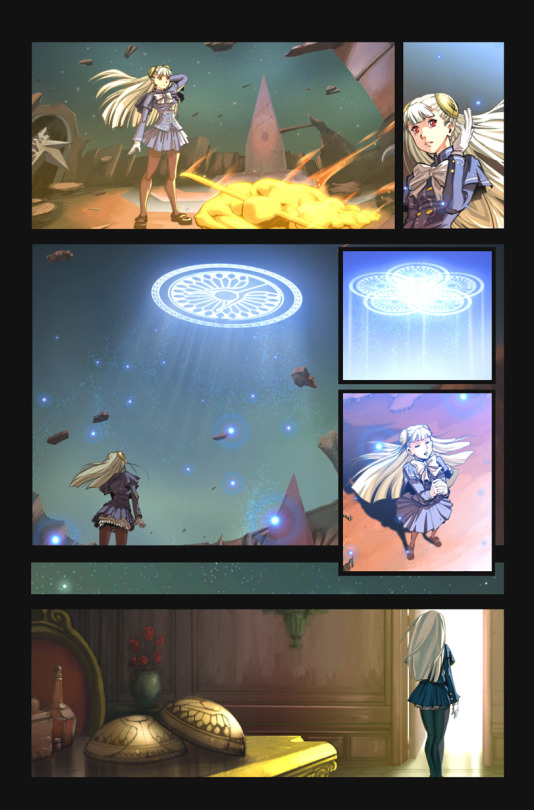
I brought this up because it adds a tiny little bit of context to her SFA3 MAX ending.
youtube
Ingrid claims ownership of the psycho power. Notice that its the power itself, not the Psycho Drive Bison's uses. And Bison is aware of that. Roses recognizes both as users of Psycho Power, even though she doesn't recognizes Ingrid. Also note at 00:59 that the focus point of the psycho drive carries Ingrid's Seal, the same one on the cups on her head AND the one she summons on her Fighting Jam ending.
Oh, and she is capable of time travel. but no mention if she was the one who brought Yun to SFA3 time, though.
What this all mean? Speculation time:
According to Steven Mane's theory: With Ingrid being the creator of psycho power, Psycho power works better with women. You can even explain Bison's obsession with 16 year old girls: They are the ones who closely resemble Ingrid, who he knows is the original source of that power. This also explain why Bison's desire of a male body directly conflicts with psycho power: It was never meant for such body. and why there is so much female clones: It simply the result of experiments to see what fits better.
But Bison is trying to get around this: He has been experimenting on both, noticing that male bodies deteriorate way faster, confirmed that female ones fit better, but for reasons only known to himself, this was not enough.
The genderless Seth, a sentient machine build to gather psycho power, was Bison's latest attempt of circumvent the body type limitation, but it still didn't work (as stated by Bison himself)
This is where Steven Mane's theory ends. But from that, we can jump to other conclusions:
Ingrid is a goddess and is the source of Psycho Power energy. Notice that she is not the source of soul power though, so behind her innocent face, behind those red eyes, lies something sinister and evil.
(Or maybe, Soul Power is simply Psycho Power with another name? Rose might be the one hiding something...) [Small June/2021 update: After a lazy Sunday re-reading the SF30th's bios, its is clear that Soul Power is not just Psycho Power with a different name. So if you want to follow this line of thought through, you have to consider that Ingrid is EVIL, or at least deals heavily with negative energies (closer to Akuma than Bison). and it opens the possibility of a God/Goddess of Soul Power somewhere out there on the SF Universe. but that is speculation for another time.]
Ingrid is time-travelling to specific points in time to collect parts of her power. Bison was one of those who stole it. Pyron probably did it too, and in 201X, Ryu has something to do with it.
Oh, extra fact: SFIII, the last game on the timeline, happens in 1999. SFV, the game that was released on the 10's, canonically happens during 1998. So the Ryu she is supposed to meet next is YET to appear (maybe in SF6?).
And because she is a time travellng goddess, not a dimension hopping one this means a direct connection between the worlds of Darkstalkers, Street Fighter and Red Earth, the three franchises from CAPCOM Fighting Jam: Darkstalkers' Human World could be considered to be Street Fighter's Earth, and Red Earth is literally another planet on the same universe, hinting a bigger CAPCOM shared timeline then we expected.
We can also speculate that Bison ultimate goal would not be just global domination but to replace Ingrid as god/goddess of psycho power.
And she took Yun to 1989 just for the LuLz.
Why I didn't mentioned Ingrid up there in MY theory? because of CFN Portal.
The Capcom Fighters Network Portal is essentially the final word on who is canon in Street Fighter. Released together with SFV, its a well documented, weirdly organized and deep source of any street fighter or final fight character you can imagine. Those 2 guys fighting on the intro of SF2 got bios there. As well as Hakan's daughters and Elena's Family. Heck, CFN Portal is the place that finally settled Chun-li's father name as Dorai.
There is also relevant guest characters and characters who appeared in other games but that CAPCOM consider part of the franchise and canon, such as Blade from the Street Fighter: The Movie game (now part of the North American operations of Shadaloo) and... Ruby Heart from MARVEL vs CAPCOM 2 (a version of her actually, before the events of that game).
Ingrid is clearly shown as a guest character and NOT part of the street fighter franchise, as she does not have the SF franchise standard background. the only ones who this happen are special guests from, such as the ones from Street Fighter EX and Street Fighter 2010.
Ingrid is also described there with her bio from CAPCOM Fighting All-Stars, rather then her own story on SFA3 MAX or even CAPCOM Fighting Jam, in a way making her role on SFA3 MAX similar to Evil Ryu's: A what-if non-canon scenario of the events of the game, that has no bearing on the main plot. Evil Ryu's ending are always Ryu kills everybody and wants more blood, never really explaining anything. Evil Ryu is more important as a visual representation of the dark side of Ryu rather than a character itself'.
and because of that precedent, when CAPCOM itself gave her non-canon status, it's better to err on the side of caution and not consider her direct influence and acts when speculating about the plot and lore, unless they are the only source of some kind of hinted information. And there is one very canon character who has a situation like that.
Killer Bee.
As I mentioned before, the ONLY time Cammy acts as Killer Bee in canon is on her SFA3 arcade/story mode: In her intro against Rose, her very first fight, She initially starts under control of Bison. Rose actually recognizes Bison's Power and frees her, even before the fight starts. The fight itself is actually framed as a violent reaction to being freed.
but there is a game where we can see Killer Bee Cammy in all her brainwashed glory: X-men vs Street Fighter. Released before Alpha 3 and the first game where Cammy is shown with her Alpha design. Her quotes there shows a profound reverence to Bison AND some are mechanical in nature.
Goddess Ingrid (to differentiate a bit from Code Holder Ingrid) could be one of these instances: Canonically speaking, we know very little about Bison: What are his motivations, why he desires such levels of power or anything that would elevate him from one dimensional antagonist. Sagat started as that and became one of the most developed characters of the franchise. Gill is from the straight go good intentions that will end up bad. Seth is the whole reason of this essay, so I don't need to show you anymore how he turned out a interesting character. and there is G, who is either a suicide cult leader still looking for followers, or the savior of mankind. Not to mention that most players thought as a good guy until Rose's ending. like, holy psycho powered cow...
Bison is still just the dictator who wants to rule the entire world.
And the only character that deals with Psycho Power in a way that is not just evil power for the evil dictator is a character that, as far as CAPCOM is concerned, is not even acknowledged as the relevant version.
#street fighter#Street Fighter V#CAPCOM#Lore#M. Bison#Ed#Falke#Seth#Abel#Cammy#Decapre#Rose#Ingrid#Body Swapping#Street Fighter Alpha#Fan Theory
59 notes
·
View notes
Text
Vincenzo: The Gentleman Villain Reborn
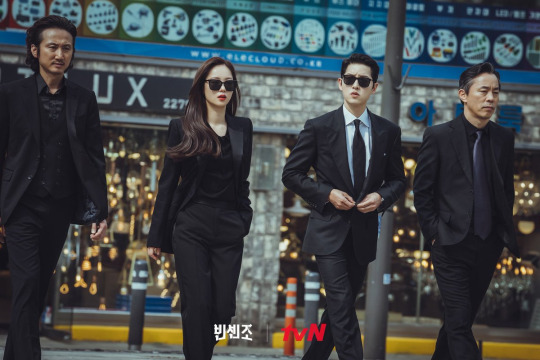
Long before there were loudmouth buff guys in spandex, there was the gentleman villain.
There once was a time when the gentleman villain, whether a gentleman thief in the Raffles or Lupin mold, or murderous arch-criminals like Fu Manchu and Fantomas, organizations like Les Vampires, and even in-between figures like Rocambole and Judex, was the coolest thing in the pop culture block. The figures right around the corner of Baker Street, when Nick Carter and Sexton Blake and any billion old serial detectives weren’t quite cutting it. Their time was not to last long in the spotlight, as the pulp heroes consolidated domain in the 30s and then the superheroes took over, but every now and then, they return in various forms, never fully gone. But I’d dare say I’d never seen a gentleman villain story quite so bold, so modern, so dynamic and so gloriously over-the-top in pride over it’s existence, until I began watching Vincenzo.
Vincenzo is BADASS and I don’t use the term lightly. Not just the titular character, but the show itself. It’s currently a couple episodes short of the finale and you should stop everything you’re doing or watching and go watch Vincenzo. It’s been an utterly glorious ride from beginning to end with no shortage of great characters, terrific writing, great relationships and jaw-dropping moments as every episode succeeds in topping each other in WOW HOLY SHIT factor. It’s a shot of adrenaline and storytelling excellence to the eyeballs and you don’t have anything better to be doing right now than watching this.
I mentioned a while ago that Black was a show that, besides being also terrific in quality, captured my interest as a Shadow fan specifically because I saw in Black what I believe is the heart of The Shadow as a character: an embodiment of evil, motivated and created and warped by social catastrophe and strife, set loose to punish true evil in order to protect humanity. In that regard, if Black is where I find the heart of The Shadow, Vincenzo is where I find the spirit of what I like about The Shadow as a series: Cathartic urban fairytales where an extraordinary agent of change, armed with incredible cunning, sleight-of-hand and combat skills, rises above a dark background to command a folk brigade of ordinary people who reveal themselves to be extraordinary through their newfound purpose, to right the wrongs of society’s predators, by being better at their tactics than they are and turning their tools against them.
I’m gonna spoil it a bit under the cut but please go watch it. I cannot praise this show enough and I’ll do my best to try.
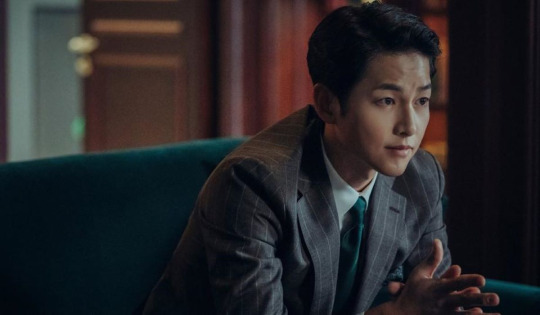
Vincenzo centers around the titular character, Vincenzo Cassano, an Italian lawyer who works for the mafia as a consigliere, adopted by it’s Don at the age of eight. After the death of the Don and an attempted betrayal by his son, Vincenzo flees to Seoul and ends up taking residence at a ramshackle building called Geumga Plaza. Geumga Plaza is the hiding place of a gigantic stash of gold hidden by one of Vincenzo��s former clients, and he intends to retrieve it to rebuild his life somewhere else. Naturally, not only is the hidden room completely impenetrable, but the building is occupied. by residents who are being forced out of it by criminals working for the Babel corporation, which intends to take possession of the building. And thus, Vincenzo has to put his skills into working out progressively bigger problems, as his efforts to uncover the gold turn into a fight against Babel and it’s lawyers, as the problems take on bigger and bigger proportions.
Vincenzo’s got a lot of what you’d expect from a k-drama at first glance. The leading man is a dashing young man, the leading lady is headstrong and stubborn, you see their romance coming a mile away and they take their damn time getting there, there’s emotional backstories that take a long time to be revealed, lots of wacky side characters and comedy interspersed with the darkest moments, a focus on corporate corruption, and so on. But it’s got an intrusion of elements brought by Vincenzo’s inclusion, such as mob drama, tonal and cultural imbalance, and the gentleman villain tropes that Vincenzo brings, as the catalyst of change whose antics backflip through action hero, romantic hero, super hero and super villain, cunning puppetmaster and gun-toting warrior alike, and start to have an effect on the world around him. His allies become stronger, more determined and effective, and the villains grow smarter and more horrid as they desperately try to avoid their own downfalls.
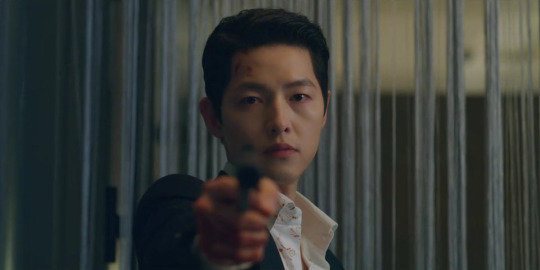
On paper, Vincenzo is almost a textbook example of how to craft a villain protagonist. He’s a mysterious foreigner with a hidden past and incredible skills who shows up uninvited in “our” world, who starts terrorizing and manipulating people into doing his bidding. He’s got a hotheaded and foolish investigator chasing after his every move, and frequently employs misdirection and sleight-of-hand to fool the authorities. He commits crimes and employs underhanded methods in the service of stamping out people worse than himself. He never really makes any claim of being a hero and actively rejects the notion he’s fighting for justice, but instead states he’s doing it as a matter of principle. One of the characters early on even states he gives off the vibe of a movie villain, even Vincenzo himself tells Hong Cha-Young, the female lead, that he’s teaching her how to be a proper villain. In another series, Vincenzo would be the hypercompetent sidekick to the main villain, or secretly the main villain, the lone badass that the action hero would have a tough fight against before defeating and moving on. But Vincenzo does not allow himself to be dismissed so easily.
On the first episode, when we’re introduced to him in Italy, he’s painted as the badass to end all badasses. But the minute he arrives in Seoul, he falls for a trick at the airport and is mugged by two cabbies, and has to walk around penniless and without dignity, shouting curses in Italian that nobody understands. He has to sleep in a broken down apartment, his “taking a steamy shower with classical music playing” fanservice scene keeps being interrupted because the shower doesn’t work, and a pigeon chattering outside his window keeps ruining his sleep.
The tenants of the building are all introduced as varying levels of unsympathetic and useless, or downright creepy. The tailor screws up his favorite suit, the chef who claims to have studied in Italy is a total fraud, there’s tenants who scare us by passing as ghosts and zombies, and Hong Cha-Young is introduced as an unlikable stooge for Babel. Vincenzo is a villain protagonist who is forced out of his grand mafia epic film, where he conducts business around lavish manors while classical music plays, and stumbles onto a korean drama, a world that operates by different rules and where no one has any reason to take him seriously at first, and gradually finds out that the difference between both worlds is not as big as he’d imagined.
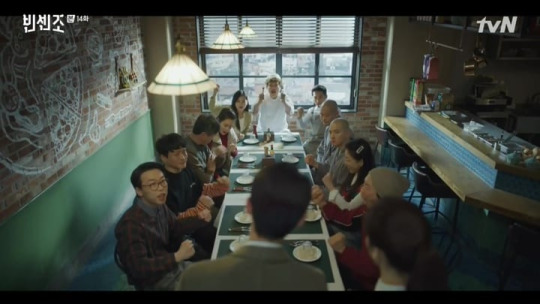
It’s only at the very end of the first episode, when the neighborhood gangsters show up to terrorize the tenants, that Vincenzo starts to kick ass again, and he has not stopped so far. In fact, not just him, ALL of the tenants have gradually started kicking ass with him. Hong Cha-Young severs all connections to Babel and proves to be, as his main partner in crime, just as cunning, twice as driven, and three times as batshit and kooky. The tailor who ruined his suit turns out to be an ex-gang member capable of fending off groups of thugs with only his scissors. The creepy piano girl reveals herself a hacking genius, the zombie impersonators become incredible actors, the failed wrestler and badass wannabe becomes his most active field agent along with his equally strong wife, the chef improves his cooking and lends his restaurant as a meeting center, all of the characters, EVERY SINGLE ONE OF THEM gradually become incredible, competent, resourceful people, really no different than they were before, it just took a little courage and pushing.
The headstrong and foolish agent pursuing Vincenzo becomes 100% smitten with him and quickly becomes one of his greatest allies. Even the neighborhood gangsters, after being left to die by Babel and forced to start anew, quickly become some of his most loyal allies, and gradually redeem themselves in the eyes of the tenants to the point they become friends. In departing from his old family, Vincenzo forms a new one, even if never by his intention. They even all get matching suits.
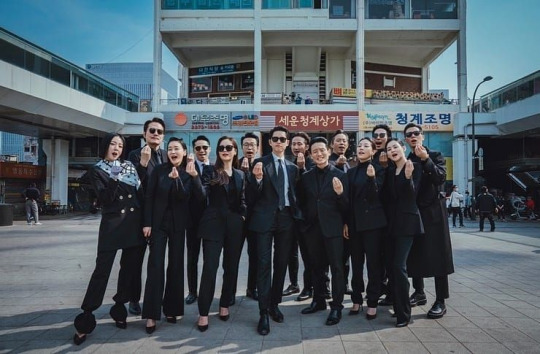
This incredibly potent, human core surrounding the antics of an extraordinary figure of action is part of what used to make the Agents of The Shadow such a special, meaningful and beloved part of the series, and something every adaptation since then has been 100% poorer for neglecting. But Vincenzo does it, and does it right. I could watch a billion adventures with these people and never get sick of them.
Vincenzo is a slick, modern take on the gentleman villain that takes many of it’s oldest conventions and provides blueprints for making them work in modern times. His plans often take a performance art-edge as he employs tactics both old-fashioned and modern, like using social media to stage an event in front of the Plaza so the bulldozers set to demolish it won’t be able to pass, or copying files and passing them to his police contact while keeping the real ones when said police contact inevitably betrays him. The tenants put all of their skills to use, no matter how unusual or seemingly useless. Every episode lays the groundwork for a smashing finale where all of the threads come together and we bare witness to a grand tapestry of karmic retribution.
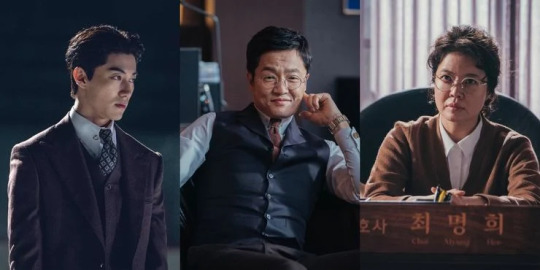
The villains themselves are no slouch, and also have that modern edge that gradually ramps up. They stage discreet assassinations involving gas leaks and watches meant to burst into flames. They stack the deck impossibly against all characters. They employ masked goons by the dozens, armies of lawyers to smudge any connections between themselves and their actions, and every sector of society in covering them, from journalists publishing pro-Babel propaganda to police commissioners. The assistant of the main villain does zumba classes amidst ordering assassinations, and is often likened to a snake and a witch with her "Crystal Ball” (the name she uses for ordering assassin contacts by the phone), complete with a cowardly, scheming assistant she bullies at every turn. The CEO of Babel has a dual nature not out of place in a Jekyll & Hyde/Dorian Grey kind of story.
The main villain is often painted as a slasher villain backed by massive corporate power, murdering people with hockey equipments and even outright named “Jason” at one point, with a tense string theme song accompanying his deeds. The show hides the villain at plain sight by using one of the most familiar set-ups of romantic dramas and the tension never stops even after he’s revealed.
Mobster films tend to paint an idealized version of it’s protagonists, not necessarily because of a genuine love or interest with mobsters (I mean, it really goes without saying that real life mobsters are obviously not admirable figures), but out of a sense of displaying a “this is what it could be” fantasy, a fantasy where the mafioso is a dark hero who will still ultimately do the right thing and stick up for the little guy, in a similar way to how superheroes often function as police officers except, y’know, actually dedicated to protecting people.
Vincenzo does go to great lengths to address the imbalance of putting such a dark figure as it’s hero, through showing how the situation can only be addressed by the intrusion of a figure such as Vincenzo. There’s a scene where Vincenzo and Hong proceed to explain extremely succintly to their cop ally why the “bad apples” argument is horseshit. One of the show’s characters, someone who’s spent his entire life being the best person he could, and dedicating himself 110% percent to fighting evil even at the expense of connecting with his own family, someone who absolutely should be the hero to take down Babel, admits shortly before dying that it wasn’t enough, that it was never going to be enough, and that what the situation calls for isn’t a hero, but a monster. That monster being Vincenzo, who is not only powerful and monstrous, but commands the loyalty of people high and low class alike, criminals and law enforcement agents, to fight Babel. In his words, “the ultimate monster”, something even the world’s biggest badass cannot defeat by himself.
On most other set-ups, Vincenzo would be pretty unmistakably the villain. But here, when he’s set up against a starkly realistic depiction of how corporations actually function in our world, depicts that Vincenzo’s ability to clear his way through goons John Wick-style is nowhere near enough, and to that end, he’s gonna have to fight impossible battles using his brains and his allies. And in the end, he defeats them, time and time again, and proves that they were not that impossible after all.

One can only hope he’s on to something.
Oh yeah and THE PIGEON BY HIS WINDOW ALSO KICKS ASS and I will not explain how, just watch the show, I can’t do it justice no matter how much I talk about it.
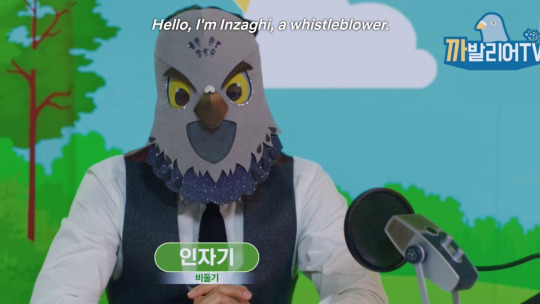
#k-drama#vincenzo#i've fallen in the k-drama rabbit hole and I am not getting back up#I love everything about this show so goddamn much#song joong ki#tvn vincenzo
49 notes
·
View notes
Photo

My Top 10 Favorite Anime Villains (Updated) by DarkChild316
In a different time and a different world, I did a list of “My 10 Favorite Anime Villains”. I am older now, and hopefully much wiser and now thanks to the global pandemic and my new subscriptions to Hulu and Funimation I’ve had the opportunity to go back and revisit so many classic anime that I feel like I should re-do it. Plus I’ve gone back and looked at my previous list and shook my head thinking to myself: “My God man, what in the f**k were you thinking with some of these choices!” So, I’ve gone back and redone the list, now this list is strictly for the men only. If you want to see a list dedicated to my favorite female villains, check out my list of “My Top 10 Favorite Anime Villainesses.” But for this list, here is my updated list of My Top 10 Favorite Anime Villains:
#10. Shishiho Makoto (Rurouni Kenshin): Growing up as a kid, Ruroni Kenshin was one of the first anime I had ever watched, and this guy was someone who I hated with a passion. Looking back at it years later, I realize now what an amazing villain and foil to Kenshin that Makoto was. Unlike a lot of villains on this list, Makoto wasn’t just evil for the sake of being evil, Makoto’s evil came from the worst type of trauma: betrayal! In this case the betrayal came from Makoto’s own government, where Makoto survived not only multiple gunshots, but being doused in oil and burned alive, leaving him in complete and utter agony. What puts Shishio on my list is what he manages to do after surviving death. He compiles an army of the best fighters Japan has to offer and plots to overthrow the entire Meiji Government. While in complete agony. Who else can claim that? Did I also mention he’s topping the list of the best fighters in the show? His swordsmanship is second only to Kenshin himself as he proves in their absolutely epic fight.
#9. Hisoka Morrow (Hunter x Hunter): Hunter x Hunter is a show with several great villains that truly stand out, and while Meruem was memorable, pardon me for believing that Hisoka was the standout villain from that show. A devious killer and master Nen user, Hisoka is driven by little more than his desire to find and kill strong opponents. Be they young children or master criminals, he’ll pursue them to the ends of the Earth with a bloodlust on par with that of a wild predator.
Likewise, he doesn’t care what happens to himself or others in this pursuit. Mass civilian casualties, the loss of his own villainous allies or even the loss of his own limbs barely phases him, so long as he gets to fight with someone that tests his limits. As a result, he more often than not embodies chaos incarnate, wreaking havoc in his pursuit of battle and leaving a mountain of corpses behind him.
Needless to say, this puts him at odds with the series’ protagonists at regular intervals. Not only do Gon and his friends fit the bill for what he seeks, but they often take on enemies that prove to be exactly what Hisoka is looking for. And yet, this also serves to make him all the more interesting. Where other villains might strike out at the protagonists and heroes immediately, Hisoka schemes, allies himself with and double-crosses people regularly, always finding the best angle to work in order to reach his goals. He may not be a world-ending anime villain on the level of a Meruem with seismic ambitions, but he’s undeniably the most interesting and brilliant villain in Hunter x Hunter to see at work.
#8. Izaya Orihara (Durarara!!): If you think of a list of top anime villains and this guy isn’t one of the first people who comes to mind, please raise your hands so I can have a few words with you in private with no cameras or eyewitnesses. The crazy thing about Izaya is that he doesn’t even realize he’s evil, and that’s what makes him great. He loves humanity; from the depths of his bones he loves us all. This is why he makes it onto my list; he does progressively more cruel acts against humans, putting people in situations that generally lead to their deaths.
He is also a master of parkour and highly skilled with a switchblade in his hand (as evident in the above picture), which he generally only uses in dire situations or fights against Shizuo. In short, I absoulutely love this guy. I thoroughly enjoyed the way he manages to manipulate an entire populous, and that’s why he’s more than earned a spot on my list.
#7. Dio Brando (Jojo’s Bizarre Adventure): You might have thought it was someone else, but it was me, Dio! All meme-worthy jokes aside, Dio Brando is unquestionably one of the most iconic anime villains of all time and, thanks to his series’ late-blooming popularity outside of Japan thanks largely to the 2012 anime adaptation, one that still feels modern in our minds.
Dio is a tenacious bastard that takes advantage of the generosity of the Joestar family to further his own power, being intolerably dickish to Jonathan by constantly tearing him down, trying to make him look bad in front of his dad, spreading rumors to sully his reputation, and sabotaging his relationships. This escalates into killing his dog (his f***ikg dog of all things!), poisoning and later stabbing his adoptive father (I mean WTF!), and becoming a freakin vampire. Even after decapitation, Dio gets his revenge and sets in motion many of the events of the series, making a formal return in Stardust Crusaders as the main villain once again. With raw ambition taken to the extreme, iconic lines, poses, and outfits, incredible abilities from Aztec mask-induced vampirism and the time-stopping power of The World, Dio’s menacing presence towers over his series and over anime as a whole, which makes him MORE than deserving of a spot on my list.
#6. Light Yagami (Death Note): Yes, he’s a VILLAIN, get over yourselves Light Yagami fanboys! Anyway, there are a number of different adjectives and superlatives that could be used to described the lead character of Death Note: Diabolical, calculating, and determined to make the world in his own image all describe Light who was easily the most clever man in Death Note, as evidenced by the layers upon layers that composed his elaborate plans. Light started out as a good kid, doing well in school and heading to a bright career in police work like his father. But when he gets possession of the death note, he begins a remarkable descent into a disturbing mastermind who becomes judge, jury, and executioner for the entire world.
But what truly makes Light's character stand out remains complicated throughout the story. His ultimate goal is to make the world a happier, safer place; a noble but perhaps misguided goal. His idealism and nobility still shine through when he doesn’t have the Death Note. When he temporarily relinquishes ownership of the death note to throw L off his trail, Light loses all memory of the death note and he reverts to his normal personality. His sense of morality returns and he shows more compassion for those around him. He even refuses to use Misa Amane to get information out of her when L asks him to. These qualities help to create a complex character who ends up being a detestable villain, yet you still kind of root for him to come out of this story as a winner.
Light’s progression through the series is marked by his sheer brilliance. He's got a calculated and strategic mind that would make the great philosopher Machiavelli jealous, and the power of the death note adds a callousness that makes him free to use people in whatever way necessary to accomplish his goals. It’s highly entertaining to see his intricate plans play out. But Light’s messiah-like ego is just as big as his brain, and that arrogance ultimately leads to his tragic downfall.
#5. The Major (Hellsing): An evil Nazi Scientist, I know everyone is just rolling their eyes right now thinking I’m reaching for the low-hanging fruit for this one, but just hear me out here. While he may seem like an obvious pick for a list like this, The Major’s goals, however, are somehow far more unhinged than what may first appear. Despite being an impassioned orator and uncompromising strategist willing to sacrifice countless soldiers, the Major himself had no especial loyalty or passion for the cause of Millennium. His sole obsession is to plunge the world into an unending conflict to the point of endangering not only the lives of others but also his own. The Major’s leadership of Millennium, his decades espousing the genocidal ideology of fascists, and subsequent war against the Hellsing organization, the Vatican, and the entire world serve only as a pretext to satiate his insatiable bloodlust. The Major is one of anime’s most insidious villains, a charismatic, nihilistic sociopath driven purely by his sadomasochistic death wish.
#4. Shou Tucker (Fullmetal Alchemist): Now, you may be recalling that in my previous version of this list, I had Envy listed as my choice as my favorite villain from this show. Well after careful reconsideration, I’ve had to reevaluate my decision and give that spot to this creep, because while Envy’s actions were despicable to a point, they PALE in comparison to this guy! He only really appears in one episode if I remember correctly, yet in that one single episode, he made more of an impact then most villains make in a lifetime, which really says a lot about this guy’s character. What was it that made him so memorable you ask? Well, it could have something to do with the fact that this man transmutaed his own dog and daughter to create a talking chimera, which hadn’t been done before, and for what other reason…all in the name of recognition in the world of alchemy! That mere fact alone made this guy the most hated man in all of anime, the fact that he sacrificed his own family for the sake of fame, with absolutely no hint of remorse, made this guy the definition of an absolute living piece of shit and the only thing worse is how the episode ended, but I won’t spoil that one for you if you haven’t seen it.
#3. Gendo Ikari (Neon Genesis Evangelion) Up next is a man competing with the likes of Medusa Gorgon for the title of “Anime’s Worst Parent”, Gendo Ikari, please step up to the front of the congregation. Now Gendo is a man who’s list of atrocities throughout Evangelion is far too many to name, but I’m going to try my best to list them here: You have being actively complicit in the premature instigation of a biblical apocalypse, resulting in a near extinction-level event that caused the death of nearly two-thirds of the human population. Emotionally neglecting his own son Shinji estranging himself from him for over twelve years, only to offer him up as a sacrificial pawn in his bid to artificially bootstrap humanity’s ascent into evolutionary godhood so that he could be reunited with his dead wife. Cloning said wife’s DNA into a harem of emotionally dependent albino ingenues who share a dogged infatuation for their creator. And that’s not even mentioning the horrific emotional abuse and mental manipulation he inflicts on Dr. Ritsuko Akagi and her mother Naoko. All-in-all Gendo is proof positive that love not only has the capacity to overcome any obstacle, but sometimes it can truly make monsters out of us all.
#2. Griffith (Berserk): Griffith did nothing wrong; at least, not by his own drives and ambitions. A peasant who grew to become the leader of his own mercenary band, Griffith was a self-driven man who pursued his desires with unparalleled efficiency. No matter the situation or obstacle, he found a way to overcome them, whether that meant facing down an army of thousands or assassinating a country’s leaders.
All the while, he amassed a legion of friends and followers who would follow him to hell and back, caring for him as much or more than he cared for them. As a result, they were dragged down with him when his ambitions saw him imprisoned, tortured and maimed. They cared little though, risking life and limb to save him and help him salvage a life with what he had left.
That wasn’t enough for Griffith though. When given the option to become a demon and continue the pursuit of his dreams, he whole-heartedly accepted it; even though it came at the cost of sacrificing the lives of each and every one of his friends and allies. But that wasn’t the worst of it, to further spite the early desertion of Guts, Griffith proceeds to rape Casca, Guts’ love interest, in front of him as Guts is held down by demons. So yes, Griffith did nothing wrong by himself. By everyone else though, he did them the worst of injustices, and continues to do so with each breath he takes, all of which makes him a compelling and infuriating villain.
#1. Johan Liebert (Monster): I’ve covered a wide variety of monsters (pun fully intended) on this list, but THIS monster (again, pun FULLY intended) truly takes the cake when it comes to anime villains. A serial killer who would fit in well in any blockbuster film, Monster told the story of a man who had truly become monstrous; a charismatic, intelligent sociopath with no other goal than to kill everyone else in the world. Johan didn't just kill people, he made other people into monsters just like him. This skill of his corruption is first displayed in his youth, when he used stories to convince the other boys in his orphanage to kill all the staff, and each other.
Johan is often compared to Light Yagami of Death Note, but the two couldn’t be any more different. Light's fatal (and genius) flaw is his own ego, which leads him to put his own life above all else, even his goal of changing the world. But Johan has never been afraid of death. Quite the opposite, he welcomes and embraces it, being more than willing to put his own life at risk, and one of his signature traits is how he challenges people to shoot him.
Another of Jonah’s signature traits is his skills as a masterful manipulator. Where Light and other on this list had to resort to supernatural means to get what they wanted, Johan just used his own wits and knowledge of human nature. He's easily the most frightening villain on this list because he’s the truest to life villain on this list and he exposes the base human nature of his victims and of human society. Monster's remarkable story was almost entirely due to Johan alone, and it’s why he’s #1 on my list.
So that's my updated list, what did you guys think about it? Love it, hated it? Go on and tell me what you think and let me know who your favorite anime villains are. See you soon!!!
Deviantart: https://www.deviantart.com/darkchild316
#shishiho makoto#Rurouni Kenshin#hisoka morrow#hunter x hunter#izaya orihara#durarara#Dio Brando#JoJo's Bizarre Adventure#Light Yagami#Death Note#the major#hellsing#shou tucker#Fullmetal Alchemist#gendo ikari#neon genesis evangelion#griffith#berserk#johan liebert#monster
68 notes
·
View notes
Text
TerraMythos 2021 Reading Challenge - Book 22 of 26

Title: Stories of the Raksura, Volume One (2014)
Author: Martha Wells
Genre/Tags: Fantasy, Adventure, Short Story Collection, Third-Person, LGBT Protagonist, Female Protagonist
Rating: 7/10 (note: this is an average)
Date Began: 8/23/2021
Date Finished: 8/28/2021
Stories of the Raksura, Volume One is the first of two anthologies that take place in Martha Wells’ Books of the Raksura universe. I recommend reading the original trilogy (starting with The Cloud Roads) before these, as the stories are pretty confusing otherwise. If “fantasy adventure starring shapeshifting, winged humanoids” sounds like an entertaining premise to you, you’re in luck! To those interested, I reviewed the main series last year— here’s a link to the first book.
Of the two novellas and two short stories in this volume, my favorites were “The Falling World” and “Adaptation”, both 8/10s.
Individual ratings, content warnings, and minor series spoilers below the cut.
Content warnings for the book: non-graphic sexual content, violence, brief mention of r*pe, brief mention of suicide, references to domestic abuse, traumatic injury, bullying, mild body horror.
#1 - The Falling World (8/10)
While on a routine diplomatic mission to a nearby court, Jade, Chime, and a contingent of warriors disappear under mysterious circumstances. Left in a precarious position in the Reach, Moon leads a search party for the missing group. The trail leads to a mysterious, ancient ruin hidden in the depths of a mountain thorn… but bizarre dangers lurk within. Finding the missing Raksura will be easier said than done.
Moon paced absently around while the others explored or drank from the pond. They were here, he thought, days ago. Just days. But standing here had the same feeling he got in ancient groundling ruins: that an unbridgeable gulf of time separated him from the people who were once here.
“The Falling World” is a typical Raksura story which takes place between the third and fourth books. If you read the original trilogy and liked it, you’ll like this one. It’s got all the pieces you’ve come to expect: creepy sorta-haunted ancient ruins, vaguely eldritch monster things, fantasy adventure, and Moon being a snarky angst machine. I wouldn’t call this novella required reading. Beyond a mention in book four, the introduction of Ocean Winter (who I don’t really remember), and a tiny bit of lore re: Chime’s weird powers, there’s nothing new here. It’s the kind of thing you read if you liked the novels and want more adventures— and that’s fine.
#2 - The Tale of Indigo and Cloud (6/10)
Umber Shadow is a minor court in the Reaches, but things are about to change. Its sister queen Indigo just “stole” Cloud, a consort from Emerald Twilight. Such behavior is one of the most taboo acts in Raksuran culture. Now Cerise, the leader of Umber Shadow, has to navigate the dire socio-political consequences of Indigo’s actions, and hopefully prevent an all-out war.
Ruby didn’t look happy, but she didn’t argue either. “All right. Just be careful. Don’t let this little idiot trap you into fighting.”
“Which little idiot?” Cerise asked, in exasperation. “There are so many of them!”
I have mixed feelings on “The Tale of Indigo and Cloud”. It’s an obvious choice for a novella, as the main books reference this story. Clearly, the titular characters are the namesakes for Indigo Cloud, the court in the main series. The plot is less action-adventure and more political intrigue— which is fine, and a welcome change of pace.
My main issue is perspective; rather than Indigo or Cloud (or both), the story instead follows Cerise, leader of Umber Shadow (Indigo Cloud’s predecessor). Cerise is well-written enough, and it’s interesting to get a reigning queen’s POV. But this choice creates a layer of disconnect from the emotional tension of the story—Indigo and Cloud’s rocky relationship. The novella comes off as a chronicle of events rather than an involved story. Personally I’d find the tale more interesting if it started with Indigo and Cloud’s meeting and took their POVs. Clearly Cloud was unhappy in his old life and convinced Indigo to help him; that’s an interesting hook that I wish we saw firsthand. That aside, I appreciated baby!Stone’s cameo and the melancholy epilogue related to that.
#3 - The Forest Boy (7/10)
Tren is an orphan living in a small Mirani village nestled along a trade route. While digging through a local junk heap, he and his friend Lua discover Moon, an injured boy caught in an animal trap. Tren’s adoptive parents nurse the strange child back to health. Moon and Lua become close friends, and Tren grows to resent the newcomer. But when a creature from the forest attacks the three children, Tren learns that Moon’s hiding a deadly secret.
He wasn’t a fool; he knew it was jealousy, like the jealous herder in one of Ari’s stories who lost his herd by trying to make it bigger than those his neighbors owned… Moon was big, strong, helpful, good to everyone, and everyone in the house liked him. He also had the added mystery of being a wild boy from the Long Road, without any of the dirty or violent habits a real wild boy might have.
But knowing it was jealousy didn’t seem to help Tren make it go away. It just made it worse, since now he could feel guilty about being jealous.
I liked this one! “The Forest Boy” introduces some early characterization for Moon; in particular, it adds context to Moon’s natural suspicion of others. Poor boy just wants a family— but he’ll always be at a remove from others since he has to hide his identity. No wonder he constantly doubts his place among the Raksura once he finally meets them. Here he finds a potential place to belong, but it comes crashing down just for being himself. It’s especially yikes knowing that this keeps happening well into adulthood. I felt kind of meh about Tren as a character, but hey, it’s a short story.
#4 - Adaptation (8/10)
Chime has been an Arbora for his entire life; the wingless caste of Raksura who keep the court running. But one day, when shapeshifting into his Arbora form, Chime blacks out. When he awakens, he finds his body has transformed into a winged Aeriat. Now with his entire identity called into question, Chime becomes an outsider among both Raksuran castes. But perhaps more troubling is what this shift means for the future of Indigo Cloud.
Someone must have carried him out of the central well; they were in one of the smaller side rooms, the one with a fountain pool fed by a channel in the wall. Chime stumbled to the pool and almost swayed over backwards. Catching himself on the rim, he stared down at his reflection.
He was looking at a Raksuran warrior, tall, lean, with blue scales. Horrified and fascinated, he raised his spines to see if they were longer, and something else extended out behind him. It took him a moment to realize he was looking at the edges of his wings as they unfolded from his back.
We love Chime in this household, so I’m happy to see a short story from his POV. Like “The Tale of Indigo and Cloud”, this was an obvious choice to write, since there’s a lot of discussion in the main books about it. Chime’s horror upon waking in a strange new body, the resulting social isolation, and his first steps toward accepting his situation, are all very compelling subjects. It’s no wonder the poor guy latched onto Moon right away. I think “Adaptation” is too short for its heavy and complex subject matter. Something like this could easily be a novella. But I did like it for what it is.
Closing Thoughts
This anthology was fine! I basically wanted a little more Raksura content, and this certainly delivered. Short story/novella collections are always going to be hit or miss with me, so I consider 7/10 a pretty good average score. As I mentioned above, only read this if you’ve read the main series, or you’ll be lost.
8 notes
·
View notes
Text
Ok guys, I can't take it, I’m seriously at my limit here.
Uraraka vs Bakuboi was a sham of a fight and none of it makes any goddamn sense.
Uraraka deserved her win, for multiple reasons.
Shout out to @bnhasalt, who’s post reminded me how indignantly furious this arc makes me.
More under the cut over both how salty I am, and how Uraraka losing against Explodo Kills makes absolutely no sense, even narratively.
(Warning ahead for a discussion on sexism, misogyny, forced fanservice, the blatant favoritism towards That One Specific Character even if unearned in the narrative, and the general incompetence on how to write female characters.
I call B/kugo “Bakuboi” in this analysis bc I don’t want to write his Actual Name out and have it pop up in his character tags. Also, heads up, I’m sorry for how messy and long this rant is )
First, can I just say that Horikoshi is uhhhh Bad at writing female characters?
Which I’m sure many female fans already have an inkling about, but goddamn is it never more obvious than in the Sports Festival Arc. Because hey, at least the female characters are THERE and PARTICIPATING and have their own time to shine! This ISN’T one of those arcs that just stars THE BOYS, so that MUST mean this arc is equal opportunity! Right...?
God, I wish. I wish...
See, the girls are the minority of the Sports Fest in general. It shouldn’t be this way. And quite frankly, the fact that the classes (and UA in general) isn’t closer to being a 50/50 gender split also makes no sense, considering all children are raised in a society that values heroism EQUALLY and almost half the population is male and half female.
But, okay, let’s say I actually believe in the most illogical character ratio imagineable of there being a 2 boy to 1 girl, like this is another round of Naruto But It’s Superheroes So It’s Different I Swear.
We all know that there is going to be an emphasis on Izuku, since he’s the protagonist and he wants to make All Might proud during the Sports Festival.
Pre-Festival, there’s the reveal that Uraraka wants to do her best, with her main motivation of becoming a hero to give her parents a good life. Iida also wants to make his own family proud, specifically his brother, because of his family legacy.
Since these three are a trio, you’d think they’d all get some time to shine, right? Since they’re Izuku’s friends? And Izuku considers them his equals?
Yeah, no. Wrong.
This arc is dominated by Izuku, Shoto, and Bakuboi. That becomes clear very quickly.
I knew I shouldn’t expect much, since these three are powerhouses and also the most popular characters of the entire franchise (just look at the popularity polls) but still. I’d thought at least Uraraka would get a chance to shine! Since we get some character development and motivation revealed from her!
But the female characters in general get done so dirty this arc, despite it being first set up as a perfect arc to let the girls have just as much opportunity to participate as their male peers.
The most significant part of the female characters all getting an ‘equal time to shine’ is when He Who Must Not Be Mentioned and Kaminari trick the girls into dressing as scantily-clad cheerleaders. Which is both Tiring and Unncessary.
(This scheme also shouldn’t have worked because Momo is Vice Rep and she is an intelligent girl, top of her class. She would be smart enough to go to a teacher and actually double-check to see if Class 1-A girls really needed to cheer in the activities portion of the Sports Festival.
But noooo, Horikoshi can’t pass up a chance for FANSERVICE and forcing his underaged female characters to be uncomfortable for The Funnies! Thanks! I hate it!)
The female characters that move onto the final round of the Sports Festival, and thusly have the most attention, are: Uraraka, Mei Hatsume from Support, Momo, Mina, and Shiozaki from 1-B.
Wow, I sure wish these girls could like...show their worth. And maybe NOT get steamrolled and easily tossed aside in their matches because they’re facing Boys and Boys Have Strong Offense-based Quirks, That’s The Rules Folks.
(Before you come at me, I know that isn’t a rule that applies to every single male character in the series, but the strongest and offense-based Quirks tend to go to the male characters, while the female characters tend to get more support-based Quirks. It’s both sexist, but also an inherent trend in media in general. Please Just Let Women Punch Shit To Smithereens And Control The Elements.)
Yes, Mina and Shiozaki won their first rounds easily! And that’s great to see! But then we turn right around, and they're eliminated just as quickly in their second matches! Without even a fighting chance!
Good God, Shiozaki is literally PUSHED OUT OF THE RING. That’s it, that’s how she lost. Same thing with Momo in her match! And Mei straight-up forfeits because her character is based more on advertising her inventions/babies, so she doesn’t even fight.
So essentially, the female characters are shucked away if they’re not used to make the male characters look good, or there for fanservice, or there to show a shallow form of ~feminism~ so Horikoshi can pat himself on the back and say “See! Girls strong! I can write girls!”
And now we get to the meat of things: Uraraka.
Oh, poor Uraraka. Out of all the female characters, your potential was the greatest, and also the most squandered...
As a reminder, at the start of the arc, Uraraka speaks with both Izuku and Iida about how she wants to do well in the Sports Fest. They all promise to do their best. Izuku’s friends admit that they want to face him in later matches, because they want to be his equals.
Uraraka wanted to stand on the same level as Izuku and Iida, but she's the only one that doesn't move on past her first match!
And man, what an absolute bogus match it is.
Is it emotional? Yeah. Did I tear up when I watched it? Sure, every single time! But that's more because Uraraka is one of my favorite characters and I feel empathy for her and thought she deserved better.
The match gets to me because I also hate how Bakuboi is so fucking entitled and gets everything handed to him on a silver platter.
Bakuboi himself is written as, essentially, a Gary Stu. He always wins. ALWAYS. And even when he ‘loses’, he still manages to beat his opponents to the point that they need to be hospitalized (see Izuku vs Kacchan pt 1) or he makes his losses ALL ABOUT HIMSELF by twisting logic to fit his own narrative.
Remember how Bakuboi won against Todoroki in the final match? And was so pissed at him he was ready to Physically Assault Todoroki for him not being able to Get Over His Trauma to go 100% during their match? And even though Bakuboi LITERALLY won the entire Sports Festival, he’s so entitled that he demands a rematch because he feels like he “didn’t actually win”?
Not wanting a rematch for Todoroki’s sake, because Todoroki has been through a rough time and Bakuboi overheard Todo’s Tragic Abusive Backstory. Oh no, that would make too much sense and show too much character growth, we can’t have that! Bakuboi, even when winning the Sports Festival, demanded a rematch because he wanted to beat the shit out of Todoroki AGAIN to assert his dominance.
You see, Bakuboi is always rewarded in the narrative. Even when he loses it’s not seen as his fault. He’s never really punished for it, and he never learns any lessons from his losses.
Ah, and let’s not forget, Katsuki Bakuboi has the Best And Strongest Quirk Ever. Strong enough to even do the impossible and work to his advantage when it shouldn’t!
Like how he SOMEHOW manages to ‘beat the odds’ by breaking the laws of physics to win in Round 2. He manages to PUNCH THROUGH A QUIRK THAT CREATES A SOLID WALL from 1-B’s Tsuburaba in order to get back his team’s headband and move on to Round 3.
Or hey, his finishing move, Howlitzer Impact? Doesn’t make any sense either. It shouldn’t work as a...cyclone? Tornado? Drill thing?
Look, the logistics of it shouldn’t work. Yes, this is anime, but do you HONESTLY think that a teenager YEETING himself in a fast spiral will somehow accomplish anything more than spreading out some explosions in a circle around him? You honestly think any other character would be able to pull that bullshit off WITHOUT upchucking their entire lunch?
But because it’s Bakuboi, it works somehow. Because Bakuboi’s Quirk is The Shining Beacon Of Quirks.
Drawbacks? Sure, he SUPPOSEDLY has them. They’re noted in his character profile and everything. But very rarely do those supposed “drawbacks” ever actually come into play and actually, like, stop him. Or slow him down. Or, yknow, ACTUALLY WORK LIKE DRAWBACKS ARE SUPPOSED TO WORK.
Because apparently, human limits don’t exist for Katsuki fucking Bakuboi, nope, not at all!
One of Bakuboi’s "drawbacks" is supposed to be that he can't overexert himself or he can fuck up his wrists/his forearms will start to ache.
Cool cool cool, except...This rarely slows him down or effects him at all.
It’s actually astounding he hasn’t given himself Carpel Tunnel, because that would be a natural consequence to over-using his Quirk. Hell, he should be fucking up his arms almost as much as Izuku does to his own arms with a destructive Quirk like OFA! Explosions are dangerous and cause massive destruction, and that should be fucking up his arms SOMEHOW!
But, nope. Bakuboi is as fresh as a goddamn daisy. He can Never Have A Weakness.
(Another drawback is cold weather/Winter season is supposed to weaken his Quirk. Makes sense, since heat would help him produce more nitroglycerin sweat, and the cold would make it hard to sweat. But that sure as hell didn’t stop him during the Joint Training Arc in the future, and he didn’t struggle whatsoever to almost singlehandedly win that for his team.)
Not ONCE does Bakuboi’s Quirk ever effect him negatively and forces him to weaken! He keeps using his Quirk like it's nothing!!
And that’s the crux of the entire problem with Uraraka vs Bakuboi’s match.
Bakuboi apparently has “drawbacks” and “limits”, but he keeps somehow managing to break them without a sweat (ha) and without consequence, essentially PULLING WINS OUT OF HIS ASS.
Bakuboi was using his Quirk LITERALLY NONSTOP during Round 1, and kept using it to throw himself around in Round 2. Logically, he should’ve fucked his arms up and been at the very least SLOWED DOWN by the third round of the Sports Fest because he went past what were SUPPOSED to be his Quirk’s canonical limitations and logic!
It would've taught Bakuboi that he can't fucking steamroll through all his problems! He has limits! There are consequences to over using his Quirk! He’s a human being and he doesn’t have endless stamina like some sort of God!
Hell, every other character has these limits very clearly shown and outlined with their Quirks! Uraraka throws up when she over-uses Zero Gravity. Shoto, before using his fire side, would get frostbite. Iida’s Engines will stall after using Recipro Burst.
The other characters have limitations to their Quirks that slows them down, shows consequences for their actions, but Bakuboi NEVER HAS ANY.
THIS is why he’s a Gary Stu. THIS is why he won his match against Uraraka.
Not because of any logic. Because HIS QUIRK HAS NO FLAWS. And on top of that, THE NARRATIVE KEEPS REWARDING HIM, EVEN WHEN HE HASN’T EARNED IT.
Bakuboi SHOULD have been weakened from using his Quirk non-stop. Bakuboi SHOULD NOT have managed to pull out that “one final big explosion” that ruined Uraraka’s final attack.
Bakuboi was literally hissing about his arms hurting earlier, before their match started. And Uraraka forced him to use his Quirk so much that she managed to amass a ton of debris to knock him out and win the match. HIS EXPLOSIONS SHOULD HAVE SPUTTERED OUT, AND NOT SAVED HIM WITH THAT LAST-SECOND ASSPULL.
Like, I’m preeeeetty sure the entire reason Horikoshi wrote Uraraka vs Bakuboi in the first place was because he was attempting at writing Feminism.
See, Bakuboi Hates Everyone Equally, he’s not a violent misogynist for beating up Uraraka! It’s a Match, he Respects Women And Sees Them As Equals! The Crowd of Pro Heroes are the ones being Misogynistic and Judging The Match Early!
And look at Uraraka, she’s a Strong Woman! She keeps getting back up! That’s the Shonen Spirit! And she’s smart, too! Look at her amazing plan to win--
Oh, wait. Wait, nope. She didn’t win at all! :) Because our shining beacon of perfection Katsuki Bakuboi never loses!! :)) Look at all her hopes and dreams being blown to literal smithereens, because of Bakuboi’s ass pull, even though he shouldn’t have had enough time, sweat, and strength to muster up that last explosion!!! :)))
Can ya’ll feel my incandescent fury right now?
Because Horikoshi can NEVER write Bakuboi losing, Uraraka COULDN’T HAVE WON, even if her winning makes THE MOST LOGICAL SENSE.
This scene was supposed to show Uraraka’s strength. But it feels like Uraraka is being literally spit in her face, for even DARING to TRY to win against Katsuki fucking Bakuboi.
How much more impactful would Uraraka’s breakdown have been, if she had moved onto the Second Round with Izuku and Iida? How she would feel ashamed that she couldn’t keep up with them, with how Powerful their Quirks are? Especially after seeing Izuku and Todoroki’s amazing match, and seen how destructive and close a match it had been?
How DEVASTATED she would have felt, beating BAKUBOI--one of the strongest of their class!--and then STILL managing to lose the Sports Festival?
That would have been SO much more interesting! And even SADDER!! C’mon!
Uraraka SHOULD have won her match! It would’ve provided both character development for herself, and for Bakuboi! Bakuboi would realize he has limits to his body and Quirk, and realize not to underestimate his opponents! Uraraka would realize that she’s strong in spite of her Quirk not being necessarily combat-oriented, but still has a long way to go in being a Pro Hero!
But, nooooo. We can’t have CHARACTER DEVELOPMENT, can we? We ESPECIALLY can’t have THE FEMALE CHARACTERS IMPACTING THE PLOT IN SOME WAY, either! Or--what’s this? FEMALE CHARACTERS ACTUALLY HAVING THE SPOTLIGHT FOR ONCE? Perish the thought!
The only good parts about this godforsaken arc are 1) Mei Hatsume 2) Hitoshi Shinso and 3) Izuku vs Todoroki fight and Todoroki’s Tragic Backstory Reveal. Everything else is hit-or-miss, if not completely hot garbage.
Anyways, thanks for coming to my TED Talk, and for reading this entire thing! Four for you, reader. You go, reader.
#Ochaco Uraraka#Ochako Uraraka#bnha meta#bnha analysis#Sports Festival Arc#Izuku Midoriya#bnha quirks#Quirk Logic#Misogyny#Sexism#Tenya Iida#Shoto Todoroki#bnha salt#salt#bnha rant#im not tagging bakuboi bc i dont want his Stans/apologists flooding my ask box to yell at me#Momo Yaoyorozu#Mina Ashido#Ibara Shiozaki#Mei Hatsume#antibaku#me being dumb#please read this ive nearly spent 2 hours writing it out#mexicat writes#fuck it this took me forever to write I'm putting it in my writing tag
415 notes
·
View notes
Note
What comparisons can be made between renruki and Ichiruki? I often wondered about this.
This is such a hot button issue that as soon as I received this (perfectly polite) ask, my body tensed up and my brain went Am I being trolled?
It’s honestly a shame that there is so much bad blood behind this, because it is, in fact, a very interesting thing to talk about, and I am going to attempt to do so in good faith, because I love thinking about this kind of thing. Even though I am very openly a Renruki shipper, I love all three of these characters very much, and I think that Ichigo and Rukia’s relationship is very important! I am doing my best to be neutral, although I have not read very much Ichiruki fanfic/meta, so please give me a benefit of a doubt. Obviously, I can’t stop anyone from reblogging this and putting their own comments on it, but I have no interest in getting in debates over it, so don’t be surprised if I don’t engage.
This is both long, and I am sure some people don’t care, so I’m gonna put the rest under a cut. I have tried to hard to write this in a way that will not make anyone mad, but if you think it will make you mad, please give yourself the gift of not clicking on it.
So, what is the same between Ichigo and Renji? Lots, actually. Physically, they are both tall, strong, and have ridiculously colored spiky hair. They are outwardly grumpy, but secretly have soft, gooey centers. Neither one of them is dumb, but they are both dumbasses. They are protectors: they would rather take any amount of pain or damage onto themselves than see a loved one hurt. Their friends are everything to them, and that goes triple for Rukia.
How are they different, then? There are three major bullets:
- Ichigo is alive. Renji is dead. Perhaps this is a little flip, but Renji belongs to same world that Rukia does, and Ichigo does not. This is not a value judgment, it is just a fact: If Rukia ends up with Renji, she stays where she is. If she ends up with Ichigo, either Rukia or Ichigo have to make a huge change. I will get back to this.
- Youth vs. Experience. Ichigo is a 15-year old boy, as we are told about 1000 times. There is some mystery over how old Rukia and Renji are, but they have graduated from secondary education and are currently employed. I think it’s safe to assume that they are roughly close in age to each other, but I think Rukia may perceive Renji as seeming older than herself-- he graduated from school, and she didn’t; he’s on his third squad transfer, whereas she’s hasn’t budged from her initial, entry-level job, and he’s now middle management. However, the arc of the story we don’t get to see, is that over the timeskips, Rukia not only catches up to, but surpasses him. Also, not for nothing, but I think that in the same way Rukia is immediately drawn to Ichigo because of his resemblance to Kaien, I think she is also drawn to him for his resemblance to Young Renji-- a grumpy, prickly young man, leaking self-doubt from every pore, whom she is more able to be generous towards through the lens of age and experience. (And I think this comparison could support either ship)
- Ichigo is the protagonist. Rules don’t apply to him. Fate breaks on his sword. He represents the triumph of love or hard work or dreams or what have you over the cruel millstone of the world. Renji, on the other hand, is firmly bound to the rules of the world in which he inhabits. In fact, that is arguably the entire purpose of his character. Renji’s fights are often used to set the stakes of the conflict-- ah, Renji got mangled, this guy must be tough. In the Soul Society Arc, he is an antagonist because he is doing what he is supposed to. In the TYBW, Kubo literally throws the two of them in a pit to fight some asauchi just to make the point that Renji is a shinigami and Ichigo is something else.
Let’s jump over to Rukia for a moment. Rukia is a great character, one of my favorite characters in any media. Rukia contains multitudes. She is tough and strong, but often melancholy. She can be beautiful and elegant, but she also lies and breaks rules and tried to put Kon in a dead cat once. Emotionally, she likes to present a cool front, but she has a big, loving heart, and she feels deeply. As a character, all of this makes her very easy to project onto, which is why I think so many people OTP her with someone, no matter who.Some people choose to try to make her into one of these things or another, and some people try to keep her as the full bundle of contradictions that she is.
There is no romantic content in canon Bleach. There is no romantic content in canon Bleach. There are many, many scenes that can be interpreted romantically, but no one goes on a date, no one kisses. Ichigo gazes longingly into the eyes of all his friends, it’s just a thing he does. Orihime does explicitly proclaim at one point that she loves Rukia, although I suspect that in the original Japanese, it’s the word for “friendship love” and not the very-rarely-used “romantic love.” I have seen a scene-for-scene comparison of IchiHime “romantic moments” only it’s Chad and Uryuu (which I choose to believe supports IshiChad, rather than negates IchiHime, but we may all choose for ourselves!) My point is that shipping in Bleach is a DIY craft, which, when we’re all having a good time, is what makes it so fun.
So, bringing all of this together, given that Ichigo and Renji are fairly similar characters, why are the ships so different, and what makes one appeal to some people and be abhorrent to someone else?
I think about romance stories a lot. I actually took a class on romance novels in college and I just really like to think about the mechanics of stories. In the truest sense of the word, “romance” is about extremes-- about sailing the high seas and wearing ostentatious shirts and shouting off a cliff in a rainstorm. When we talk about romance as a genre, the characters tend to behave in a way that we would not prefer our actual romantic partners do, but the over-the-top nature of it makes us swoon and our hearts drop -- except when it doesn’t. What is heart-breakingly romantic to some people can be a huge turn-off to others. The biggest fight my husband and I have ever had was over a kdrama. The male lead was hiding his identity from the female lead in order to help her, and I found it all to be deeply, deeply romantic, and my husband turned to me and said “He is being dishonest with her and I think it’s morally wrong” and I almost died.
So, let’s break down some of the themes of the two ships, which I think gets at the meat of what you were asking. Now, like I said, shipping is very participatory, and anyone may have their own ideas of how these relationships would be, and I am a big fan of “a great writer can get away with anything”, but in broad strokes, I think that these are the themes of the two ships:
IchiRuki:
Love conquers all/ Love is enough to overcome differences of class, age, lifestyle, geography, etc.
Instant connections/Love at first sight
Love is a force of the universe that cannot be denied or defeated
Young love
Grand gestures
Your partner changes you (in a positive way)/You effect change in your partner
Your partner is the center of your world
Your partner is the one person who can get through to you/You are the one person who can get through to your partner
Banter
Dumbassery
RenRuki:
Love takes work
Best friends to lovers
Second chances/Broken things can be repaired
Love is a choice
You improve with age
Shared experiences build love
Pining
Working together with your partner to create a mutually satisfying life together
Your partner enriches your world, but your independence is maintained
Banter
Dumbassery
There is also some degree of character interpretation at work, too-- there seems to be a huge degree of disagreement between fans as to whether:
a) Ichigo enjoys his normal, human life, and even though he do anything to protect what he loves, he would prefer to live a human existence with his human friends and family. He credits Rukia will helping him realize his strength and powers.
b) Ichigo is unsatisfied with his human life and that meeting Rukia opened the doorway to a life of excitement and adventure, on top of being given the strength to protect his loved ones.
As far as Ichigo pairings go, I think that most IchiHime people fall in category (a) and most IchiRuki (and GrimmIchi) shippers fall in (b). In both cases, peoples’ ships align with their view of what makes Ichigo happy. Most IchiRuki content I have seen seems to feature Ichigo moving to Soul Society, rather than Rukia moving to Karakura. Rukia pretty explicitly indicates at the end of the Soul Society Arc that she wants to stay in Soul Society, plus she’s got a pretty established life there. Contrast that to the story of Isshin and Masaki-- Isshin seems pretty flippant and disaffected about his life in Soul Society; it doesn’t seem like it was a particularly hard choice for him to give up being a shinigami. Also, it’s pretty clear that what Isshin did was illegal, and I’m not sure there would be an easy way for Rukia to just say “WELP, I’m off to live as a human, smell you jerks later.”
To try to wrap things up, I think the actual dynamics of an IchiRuki or RenRuki relationship would be very similar, actually. They would banter a lot and dive headfirst into danger and support each other no matter what. Byakuya would treat either guy with the vaguest, most grudging amount of respect. The primary perpetual, unresolved argument between Rukia and Ichigo would be “The Living World is dumb/Soul Society is dumb”, whereas with Rukia and Renji, it would be “Squad 6 is dumb/Squad 13 is dumb wait no I didn’t mean that Captain Ukitake is an angel.”
Personally, I headcanon Renji as being more able than Ichigo to step back and be the support person in the relationship (see that bullet about Ichigo being the protag), so I think that RenRuki could manage to run a functional household, whereas Ichigo and Rukia would just go on adventures until they got arrested for tax evasion.
*For the record, I am very pro-IchiRenRuki, except that they would be even worse at running a household. It’s just Renji trying to explain how a chore wheel works while Rukia and Ichigo walk out the door on him.
#shipping discourse#they're just all very shippable!#with each other!#with anyone!#may god have mercy on my soul for venturing this close to the third rail of bleach discourse
40 notes
·
View notes
Text
Karra Marron
“I already know my worth and I don’t needed to be told by anyone”
“Passing on the will of Noelle Silva? Sounds fun I’m raring to go!!”
Character Information
Meet Karra Marron! Magna’s and Sol’s second child a commoner of the clover kingdom
Karra is the leading female protagonists in White Clover and is a member of the generations fearsome three
Latin, Irish, Gaelic origin meaning “beloved”
Alias
Delinquents Daughter (the villagers)
Will carrier of Noelle Silva
Little Rascal (By Sol & Magna)
General Infromation
Status: alive
Species: Human
Gender: Female
Affinity: Compound of Earth and Flame
Age: 11 (at the start of White Clover)
Birthday: April 17th
Constellation: Aries
Height: 149cm
Weight: 40kg (88.18p)
Blood type: A
Eyes: purple
Hair: light brown
Apperance
Karra is taller than the average 11 year old usually being 144cm while standing at 149cm.
Karra has neck length light brown hair, brown skin and purple eyes.
Karra’s regular clothing style would be a sleeveless top with white borders on each side with a few tares, navy blue shoulder length glove on her left arm that shows all her fingers except for the thumb connected to the sleeve and tied around her waist is a blue jacket with cotton on the borders she normally wears in winter. For the bottom Karra wears navy blue baggy pants and brown boots
Personality
Karra is the total oppsoite to Noelle. Because of her home environment of masculinity and femininity Karra just dosen’t care about gender and even mentioned once that dating both men & women are fine to her though growing up in a family where her parents argue about cereal every morning (usually) Karra has grown dense to love assuming marriage is all about arguing. Unlike Noelle Karra tends to be more open and isn’t afraid to be herself around anyone and not to mention her rowdy with her older brother. Any time a challenges occurs Karra is always the first to raise her hand and the last to runaway. When it comes down to business Karra knows when to be silly and when not to be in dire situations often relying on her strength to solve it.
Traits
Dense
Feminist
Dumb
Strong
Brave
Faithful
Extremely dumb
Relationships
Family
Magna Marron
Karra has always been a “daddy’s girl” from their love of spicy food to their wild and predacious personalities and because of Magna’s soft side he grew to have a connection for Karra from the moment he held her. Aside from all the cute shenanigans Magna and Karra are always the first ones to start a fist on fist rally
Sol Marron
Karra and Sol share the same traits of being both feminists. Sol cares deeply for Karra and has always been worried of her well being being afraid of her going through the same thing she went through as child. Karra is honestly the proudest daughter alive to have Sol as a mother being a member of the blue rose knights Karra would go on for ages on how amazing her mother is and her magic attribute though she never understood why she use to be attached to Charlotte for many years
Karra’s older brother
Karra and her older brother always had a close sibling connection both having an age gap of 4 years (Him being 15 at the start of White Clover and Karra being 11) aside from that Karra and him grew up both ruffians though he started growing a habit of being more tired and sleeping more and the duties as a magic knight leaving no room in his sechuldue to spend to time with Karra. Standing from the bigger picture these will always love each other
Fearsome 3 or New Light Triad
Ace Silva
Ace and Karra have known each other since diaper days and because of their dads close friendship they would always have play dates. Karra views Ace as her closest friend and wouldn’t hestitate to give up her life for him though at some stages Ace can get a little awkard and can seem nervous around her which only makes Karra confused but she pushes that thought away and overall appreciates him and everything he’s done for her
Mirage Aldai
As well as Ace, Mirage and Karra have known each other since diaper days. These two had always have that relaxed persona, sometimes Mirage has to play “mother’ in Karra’s reckless and mindless states. Primarily Karra shows a deep interest in Mirage’s magic affinity of Forcefield and sees unlimited potential in him and tells him every time whenever he used his magic yet Mirage does get nervous when’s he’s openly compimented leading Mirage in being a hot red mess however Karra tries to control this and not openly compliment him.
Others
Noelle Silva
Noelle is Karra’s mentor and the will carrier of Noelle’s legacy of the light triad. Despite their difference in magic affinities Noelle always wanted a student like how Mereoleona was to her mother Acier then Karra came along and made her life a little more brighter. Karra had always loved Noelle and always admired her strength and courage and would never get tired of her stories of her fighting on the battlefield and wanted to aim to be like her, Karra even asked her mother she wanted to live with Noelle when she got older.
Genji
Karra thinks of Genji as an emotionless robot who suffers to show emotion but when she does she’s always pointing it out, always cussing him headaches and trouble. Karra’s opnion on Genji is currently the person out of everyone they had less interactions with but always like starting a teasing partying for him.
Battle powers
Magic
Compound Magic/dual affinity: Karra possess the ability to use Flame and Earth magic but unfortunately the two however Karra can manipulate the crust of the earth and create as well manipulate hell fire and create fire
Creation Magic: Karra uses this form of magic to shape objects and entities from Fire & Earth
Abilities
Immense magic power: Its nearly impossible for commoners to wield such large magic power people assume that’s because she has two magic attributes she gets the upperhand but there might be another reason why she posses such high magic power, Karra has proven this from being able to use her hands underground to generate large mana to the point where she could move one of the teutonic plates without the need of a grimoire
High Durablity: Karra maintains a high durability through the toughest situations in a sparring match against Yami Karra was able to stand on her own and even able to him with 2 attacks
Enhanced Strength: Karra is nowhere near as strong as Asta but for her age group she is mightier even being able to carry both her parents if she eats the right nutrients in the daily
Creative Mana: Both of Sol’s children inherited her creative mana, able to create weapons & beings out of Earth and Fire if in the right environment
Neglected by Mana: The disturbance of mana waves in ones own body can cause affects of complication one having immense magic power and low mana read. Vice versa.
Mana moves: Being neglected by mana Karra cannot do simple hand signal spells she has to do body movement spells
Weapons
War Hammer: Karra can create a war hammer out of flame obstructed by earth this one of the only ways Karra can use both Earth & Fire magic
Physical Strength 4/5
Magic Amount 5/5
Magic Control 3/5
Magic Sensing 1/5
Cleverness 4/5
Toughness 5/5
Trivia
Karra was inspired by Korra from legend of Korra
Karra’s favorite food is Spicy Grilled Salmon Kabobs
Karra likes are mud baths and vine swinging
Karra has a strange fear of squirrels
Favorite color is blue
It’s estimated that if Karra wanted to become a Wizard king she’ll achieve it at the ages of 18-20
She easily forgets named
20 notes
·
View notes
Text
Chihayafuru | Why read it?
This is a comprehensive, non-spoilers review I made of the series on Goodreads recently, and I thought I would leave it here for potential readers as well. As the series will come to a close within the next year or two, there’s no better time to pick up Chihayafuru than now. The following review covers: a basic summary of the series, a brief explanation of karuta, highlighted aspects of the narrative, and common misconceptions. Enjoy!
Chihayafuru primarily follows three childhood friends—Chihaya, Arata, and Taichi—and their journey through karuta, a Japanese sport inspired by one hundred classical poems found in the famed Hyakunin Isshu. The trio bonds over karuta as children before they're inevitably separated due to a number of circumstances, until their paths cross once again in high school. Their efforts to rise to the top of the sport's hierarchy in Japan parallel to their personal relationships with each other, as well as their insecurities, hopes, and fears for the future as they grow up.
REP: visually disabled SC.
TW’s: verbal parental abuse.
Karuta (or more specifically, kyogi karuta) is a Japanese card game. The poems of the Hyakunin Isshu are transcribed onto two sets of one hundred cards each—the yomifuda, or reading cards, have a full poem transcribed onto them, while the torifuda, or grabbing cards, have only the second half of a poem transcribed onto them. Each player has a territory with twenty five cards, and the object of the game is to grab the correct torifuda as soon as the corresponding yomifuda is read. There are also a few more complex rules, but ultimately, whoever clears all of the cards in their territory first wins. Karuta is a game that tests memorization, agility, hearing ability, strategy, stamina, etc.
The following are aspects of the series that I think really make it stand out!
The expansive cast. Karuta is an all-ages competitive sport. People from all walks of life compete against each other, so there's a broad range of characters introduced across the course of the series: old doctors, married women, high school teachers, elementary students. It makes the personal experiences and learning points of the various characters all the richer. The appearances of background characters are also consistently recurring, which makes the fact that the cast is so expansive even more enjoyable, because no one is truly forgotten or cast aside.
The emphasis on teachers. An experience Chihayafuru especially explores in depth is that of teachers, both literal and figurative. They are constantly brought into focus: as competitors capable of displaying as much persistence as their juniors, as mentors who do their best to nurture the younger generation, and as people of a past era fighting to hold onto what grasp of the present that they have left. Their insight is invaluable to the younger characters that the series primarily focuses on, and they can hardly be called backseat players.
The exploration into parent-child dynamics. Although the angle from which Chihayafuru explores parents and their influence on their children is a little different, it's also a just as valuable portrayed experience that I adore. There are parents who give their everything for their children, parents who don’t understand their children’s ambitions but support them as best they can, parents who demean those ambitions and create everlasting insecurities, parents who use their children’s ambitions for their own gain, etc. I think in that sense, there’s at least one parent-child dynamic that every reader could potentially relate to and find catharsis in reading about as these relationships grow and change.
The series' refusal to treat karuta as insular. A lot of sports manga have a tendency to focus almost exclusively on the sport in question, with no thought given to the characters' real-life problems, their families, or their future after high school. Chihayafuru, rather than making karuta the object of its story, instead makes it the narrative medium by which the characters' life stories are told. It's a series about people and their problems more than it is a series about the sport, which is what best sets it apart. The characters are constantly faced with the reality that they will have to confront their future and the need for a career at some point, because karuta isn’t a sport that pays nor one necessarily super-famous in Japan.
The use of poetry to parallel the events of the narrative. On the surface, karuta is just another card game; but what makes Chihayafuru special is that the poems being read at different parts of the story actually further contextualize what is happening. Although the course of the story can be understood without looking up what each mentioned poem means, there’s no denying that looking up the meanings adds so much more to the experience. It's one of the best Easter eggs the series has to offer, and it also lends further understanding to why players must cherish the cards for what they mean in order to truly love the sport. (Also, if you are into classical poetry and/or the use of nature-associated metaphors to illustrate life, this will definitely appeal to you!)
The analysis of the human psyche. There are several types of relationships and personal problems Chihayafuru explores. In particular, the friendship between Chihaya, Arata, and Taichi is complex. Their love triangle is deeply entrenched within each of their individual relationships with karuta and their individual insecurities, which is what makes it stand out to me as one of the best of its kind. Each of these characters undergoes expansive development as an individual, and yet the three of them are also inextricable of each other in terms of that development and their goals. There’s extensive exploration into what it means to truly love a sport, whether natural talent or hard work is more valuable, how ambition and success achieved at the cost of loneliness is to our own detriment, and whether the expectations of an older generation will define all that we are capable of becoming.
The exploration of playing as an individual versus as a team member. Karuta is a sport that can be played in teams (up through the end of grade school) or individually. Both aspects of play offer different insight into the nature of sports in general, about the characters' personal goals or desires, and about their complex relationships with the support systems that surround them, or lack thereof. There’s a huge emphasis put on the fact that ultimately, while experiences garnered while playing alone are valuable, karuta cannot exist on the backs of isolated individuals alone. Human camaraderie is necessary in order for the sport to thrive. One of my favorite quotes from the series is regarding this complex theme: Team matches are solo matches. Solo matches are team matches.
The women! Among its equally (or more) famous peers, Chihayafuru is perhaps the series that emphasizes on uplifting of women and women's friendships the most (an advantage lent to it by the all-ages, all-genders nature of the sport). There's a vast cast of female characters, and Chihaya and Shinobu in particular are protagonists whose strength is never undermined by the fact of them being women or the object of someone's affections. The women of the series are strong, air-headed, determined, lazy, ambitious, lost. There’s a vast array of experiences illustrated by them, and they’re allowed to embrace their womanhood while also refusing to be limited by it.
Here are some misconceptions about the series that I have seen encountered by both dedicated and casual readers (or viewers):
It's a series with little emotional payoff. As I mentioned before, Chihayafuru is most prominently a series about people and their problems. The personal journeys the characters undergo span hundreds of chapters. I've noticed before that some people give up on the series as a result, because their favorite character isn't where they want them to be within whatever span of chapters, but I want to encourage potential readers to not give into this inclination! This is a series where you need to be in it for the long haul, because the emphasis is that these emotional problems characters face are not ones that they can solve within the span of a few months. Sometimes, they take years (aside from the first volume covering a flashback sequence, the main narrative takes place over the course of three years).
Perception of the love triangle. A lot of people tend to zero in on the love triangle and make it their focus of reading, and especially for readers who attach themselves to Taichi, this often leads to disappointment in where the narrative leads (as he is a character who struggles immensely on his journey towards growth and self fulfillment). It's important to remember that each member of the childhood trio is their own individual! Issues tied to the love triangle are certainly important, but readers often miss out on crucial emotional development for characters because they're too focused on who they think Chihaya should end up with, when that's not even remotely the point. The narrative almost always emphasizes that at the heart of it all, Chihaya, Arata, and Taichi will always have each other. What matters more than the outcome of the love triangle is whether their friendship will ultimately heal and thrive, and whether they will grow as individuals who can support each other rather than act like crutches for each other.
This is not a series about sports! This may be a confusing thing to say, and it may not even be something that other Chihayafuru fans would agree with me on. But again, I'll reiterate: Chihayafuru is most prominently a series about people and their problems. Some matches can span several chapters, while others barely last a few panels. The focus is not so much on the sport as it is on what the sport or match is doing emotionally for the individual. In that sense, it's a bit different from its contemporaries, where almost every important match is covered in detail, from one move to the next. Although there are plenty of moments where karuta matches are covered in detail, don’t be surprised if there are moments where they proceed too fast, and think to yourself why showing the whole match may not have been necessary!
These are the main points that I could come up with, but if you have any questions, feel free to send me an ask on my blog. I hope any part of this can convince you to read Chihayafuru, as it’s a wonderful story that offers a lot of layers to dissect to its audience. There’s always something new to discover with it, and that’s what makes it special.
#chihayafuru#ayase chihaya#mashima taichi#wataya arata#wakamiya shinobu#meta#i'm just tagging them all so it gets spread gjfkgjfkdhl#but uhhh. i hope this is comprehensive#also if you disagree with anything pls send me an ask!#rather than reblog onto it with an essay or something gjfkjhlgdf#since this is a recommendation post i want to keep it clean#and as accessible to others as possible
40 notes
·
View notes
Text
Magatsukami. On Yato’s attitude towards his job
I might be a little late for the party with this kind of analysis (I mean, magatsukami who? we only know Yatogami-sama, the god of fortune). Still, have fun with this one *throws another lengthy-ass post at you*
`````````````````````````````````````````````````````````````````````````````````````````````````
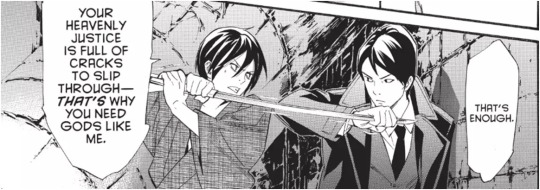
It probably won’t come as a surprise to anyone that my favorite character in Noragami is the noragami himself. I mean, what did you expect? Yato is an excellent protagonist who holds the narrative focus really well and whose character development is interesting to observe. A lot of things can be and have been written about him, his relationships with Father / Nora /Hiyori / Yukine / Kazuma / Ebisu / etc. What I want to examine is his attitude towards his calling of a magatsukami, or god of calamity, throughout his known life.
Past
I think it makes sense to start from the beginning, i.e. from Yato’s childhood, when his job was nothing but a game to him. Father created him to “cull the heard” and named him Yaboku. He knew what Father’s wish was from the start, even before he got Hiiro as his instrument. Naturally, there’s nothing to say about Yato’s attitude towards his role as a magatsukami at this point – little Yaboku probably doesn’t even know the term. Here, Father is teaching him how to be a god – in his opinion, anyway.
Rule #1: gods can do whatever they want. Father teaches by example: Yaboku can come and take anything on display in the market without paying for it; since no one can see him, no one will notice anything missing, and if they do, they won’t know who stole from them. A nice little lesson, isn’t it?
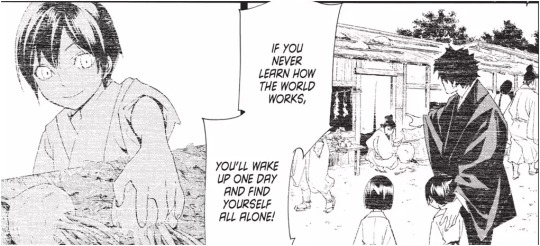
Rule #2: gods must fulfill human wishes. Father means his own wish, of course, but divine instincts show through, so Yaboku regards any request as a wish/prayer – like when his victims beg for their lives, for example. Except Father’s wish (or Yaboku’s own wish to make his father happy) is stronger, so those prayers go unanswered.
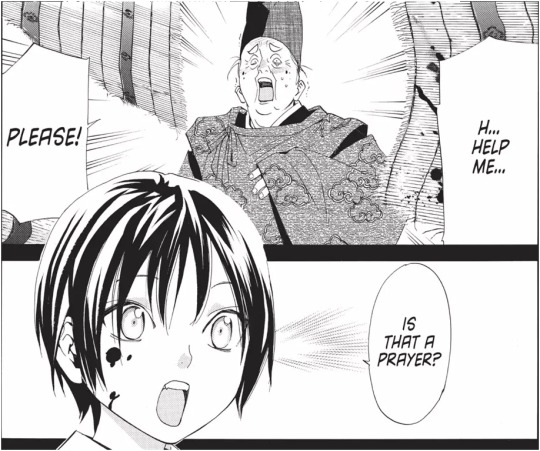
That’s how Yaboku starts fulfilling his role thinking of it as merely a game. What’s curious is that he seems to have had doubts about Father’s wish before the very first “game”:
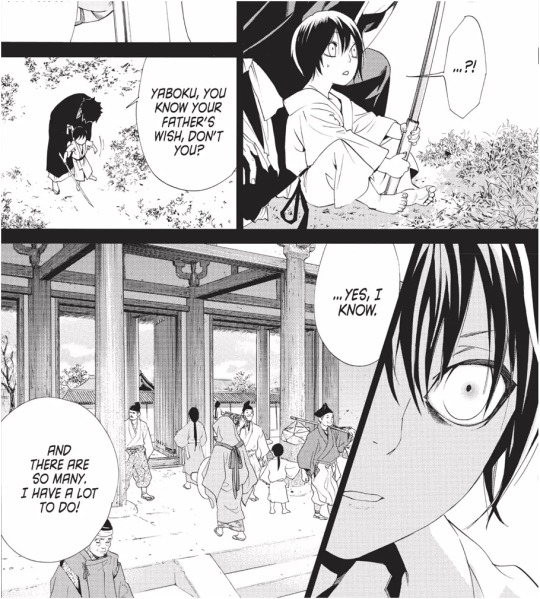
But even if he’s had those doubts before, they are completely gone when Father praises him. After that Yaboku hasn’t given much thought to what he’s doing, cause the more ears he brings home, the more Father praises him, and what else can a child dream of? And as a child he also asks his innocent questions that make your skin crawl – e.g., how come there was another human inside the belly of a woman he “played” with?
That’s how it was before a nameless shinki stumbled upon Yaboku – a shinki whom he named Sakura and who started calling him Yato by mistake. Sakura starts teaching Yato right away, probably without even stopping to think where he got those disturbing habits in the first place. It’s understandable though since she hasn’t been a shinki for that long. Sakura doesn’t know much about the Far shore, including things that are crucial to her survival – like how the water from a spring can heal her blight; it’s unlikely that the thought of a god having a parent who’s raised him to be way he was would have crossed her mind. But she has some very strong views of good and evil, and she starts conveying them to Yato as well, and with a nice and clear reasoning at that. Sakura doesn’t tell him that stealing is wrong “because she said so” – she explains that taking others’ belongings and disrupting the established rules of human interactions by doing so will lead to driving other people away and being left all alone. Unfortunately, she doesn’t have time to teach Yato the value of human life before he takes her to “play” with him instead of Hiiro.
Of course, Sakura is shocked that Yato’s used her to just up and kill an unsuspecting man, so she stings him and runs away. However, she comes back after her conversation with Tsuyu regarding the nature of the gods and keeps teaching Yato to love and have sympathy for humans. Nevertheless, the incident with the man who was dragged by his horse shows just how much Father’s lessons are engraved in Yato’s brain. The first thing to come to his mind is to slay the horse; luckily, Sakura is fast enough to tell him that he’s supposed to cut the rope, so the man is saved and Yato gets his first show of gratitude from a living human (Father doesn’t really count). From this point on, Yato is not as keen to go and “play” with Hiiro, but he doesn’t abandon his games completely because he still wants to be praised by Father.
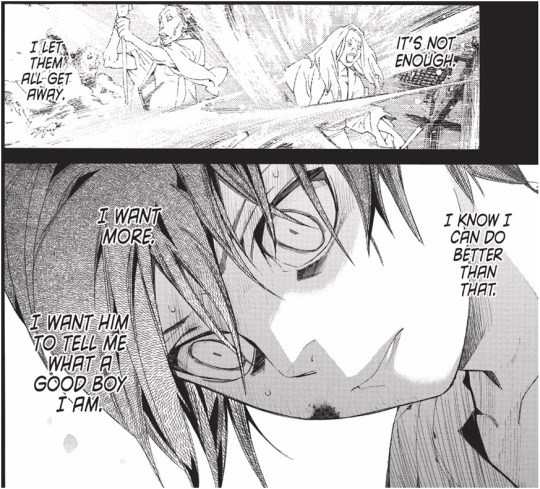
So Yato keeps “playing” with Hiiro while also helping out humans with Sakura. It’s the beginning of recurring future situations when Yato will have other shinki whom he won’t use to fulfill Father’s requests and simply disappear for a while to do his job as a magatsukami instead.
It’s pretty obvious that Yato has never got over Sakura’s death – he prefers the name she’s given him, and he also gives his new shinki a part of her human name. But there’s something else to consider. When Sakura explains to Yato what shrines are for, she asks him to be respectful towards any and every wish, and he remembers that.
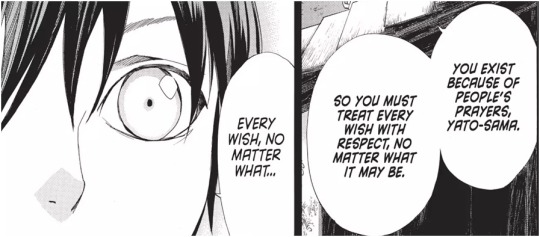
It’s the same thing he tells to Rabo in “The clash of the gods of calamity”. It’s hard to pinpoint when exactly this extra takes place, considering the only historical reference here is the Toshima clan, which existed in 8-15th centuries, and there’s no way I can determine the time period by people’s clothes. Knowing that Yato was born in 10th century doesn’t help much cause it means that the events of “The clash of the gods of calamity” could take place anytime between 10th and 15th century.
Anyway, for a small extra like this, quite a lot of things actually happen in “The clash…”. Yato is seemingly working on his own now. For the usual payment of five yen he is asked to avenge a girl who was robbed and killed by a female thug from her own village. He and Hiiro come upon some ayakashi-possessed bandits while looking for that woman. They try to kill Yato but fail cause he kills them first, without hesitation or regret.
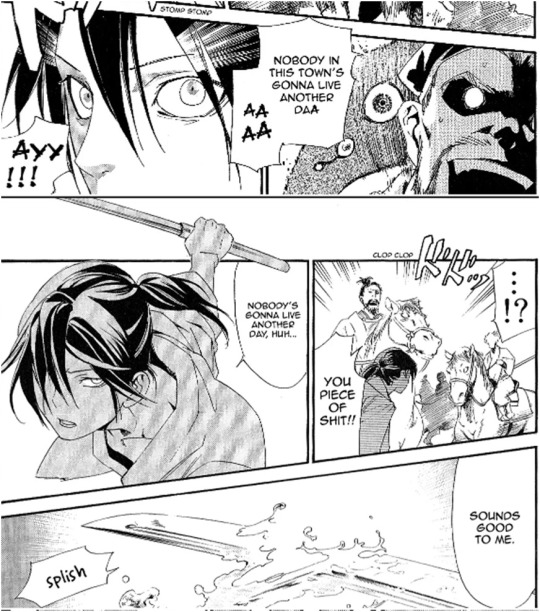
By the way, the “clash” of the gods of calamity isn’t that much of a clash, really – Yato and Rabo simultaneously slay the last gang member and that’s how they get to know each other. Well, sometimes that happens.
I find the next scene very interesting though. Rabo is pouring wine to Yato’s cup, not knowing that the latter has never drunk the stuff before since Father thinks he’s too young for that. As soon as Yato hears Rabo saying that if his father forbids then he really shouldn’t be drinking, he chugs down the entire bottle. It shows how Yato is already trying to defy his father, even if it is with small acts like that since he’s unable to do much else. And Hiiro calling him Yato and not Yaboku proves that at this point Yato is refusing to go by the name his father has given him and uses the one Sakura’s made up instead. And as they say, drunkenness reveals what soberness conceals; so when Rabo expresses the thought that Yato’s impressive battle skills could attract the attention of samurai, Yato says the same thing Sakura said before, adding a little more of his (or rather, his father’s) thoughts to it.
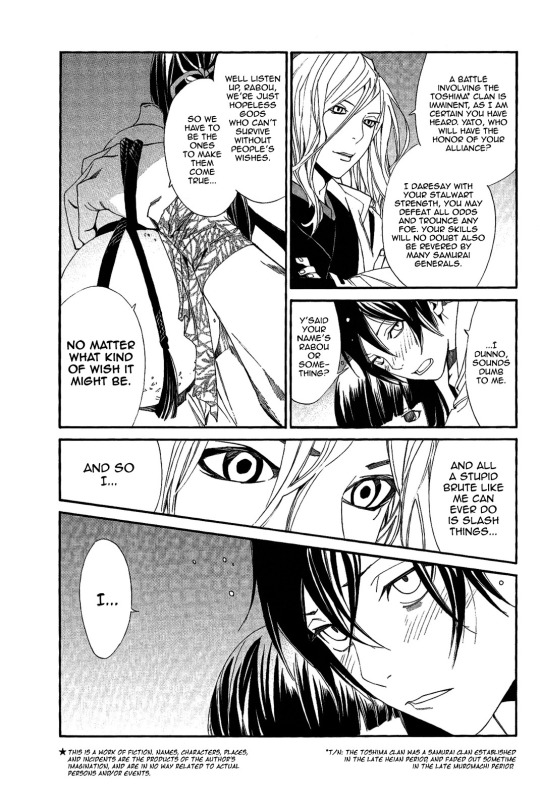
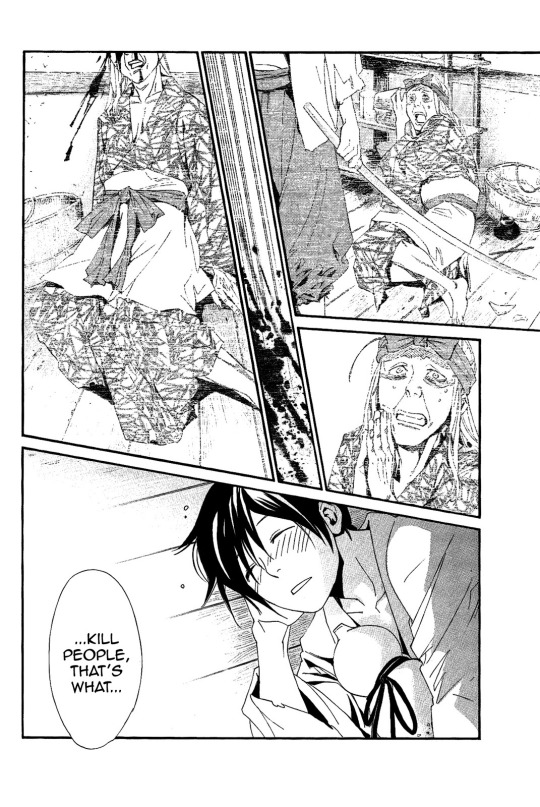
And yes, Yato actually finds the woman he was tasked to kill by the victim’s brother, and brought back a kimono. After all, the brother’s wish not so much about killing that thug as. It was about bringing back the kimono that was stolen from his sister’s dead body so that she may rest in peace. The drunken confession and the situation with kimono show that Yato, who was torn between Father and Sakura as a child, has learnt to compromise. He will be doing what his father demands of him and fulfill his role of a magatsukami because Sakura asked him to treat every wish with respect.

We don’t know what Yato had been doing for the next 300-800 years. Chronologically, the next event in his life we know of is the slaughter of the Ma clan, which happened sometime 200 years prior to the events of the manga. By that time, nasty rumors about him have been going around on the Far shore.

How true the rumors of Yato’s avarice were is hard to judge. Apart from the Bubble era, when his customers would pay him in thousands of yens, he is shown to only ever take 5 yen per wish. Granted, he’s had some side jobs as well since saving up for his shrine by granting wishes only is pretty much impossible. He’s tried to become a pop-idol, has sold rhinoceros beetles and Bishamon doujins, but even in those cases his prices, apparently, would always fall to 5 yen in the end (or maybe that’s the price he’s wanted to have and simply used the old marketing ploy of fake discounts).

Or maybe what Kazuma refers to as avarice is Yato taking the money for the prayers in person and for every one of them. After all, renowned gods have a different approach to granting wishes. They can’t possibly respond to every single prayer left at their shrines, so there’s probably no clear proportion to the number of prayers heard and granted in their case. People simply pray to them and hope that one day their wish comes true and the gods try to grant those wishes whenever they can, but unlike Yato, they don’t actually appear in front of their believers.
Anyway, when Kazuma pleads him to slay the Ma clan, who are turning turning into ayakashi en mass, Yato does ask whether he can actually pay for his prayer. But when Kazuma answers that he’d rather return his name to his mistress than become a nora, Yato agrees to grant his wish without down payment.
If you really think about it, Yato didn’t have anything to gain from this particular job. Suppose Kazuma keeps his word and pays later, so what? He’s a shinki, not a living human; is there any point in granting the wish of someone who can’t help Yato spread his name among the living? The way I see it, Yato shouldn’t care whether other gods or their shinki know about him, as for him the only thing that matters is to be remembered by humans. It’s also not a job from his Father that he wouldn’t have the guts to turn down. And yet Yato takes the request anyway without even telling Kazuma how much he’ll have to pay. Maybe he thinks that Kazuma can figure out on his own that the price is 5 yen; or maybe he doesn’t intend to get the money at all.
The thing that caught my eye in the scene where Yato slays the Ma clan is his reaction to their deaths. He starts cutting them as usual but then stops and doesn’t want to continue, so Hiiro has to persuade him to keep going.
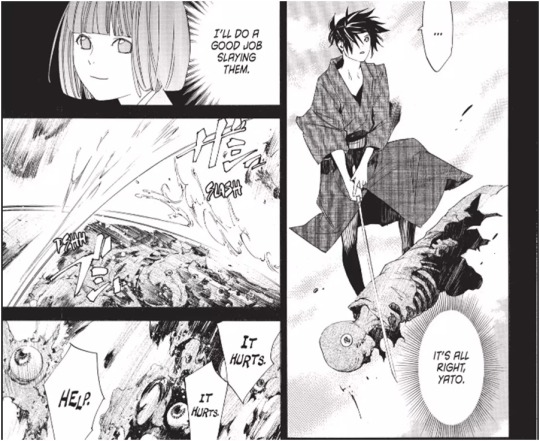
This whole situation is probably an unwelcome reminder that he had to mercy kill Sakura, who also turned into an ayakashi. I actually find it curious how Yato seems to make a distinction between shinki and humans. If we go back to his childhood again, he used to kill humans without giving much thought to the fact that dying kind of hurts. But he instantly recognized that Sakura was a shinki and helped her wash away her blight for no apparent reason. In other words, he knew what compassion was (which Tsuyu also noted when Yato came looking for Sakura to Sugawara-no-Michizane’s shrine) but he only felt it for shinki, not humans. Sakura was the one who made him extend that compassion to humans, too (I’m starting to think that this post should be renamed into “1000 and 1 reason why Sakura is awesome and deserves more love”). What I’m saying here is that maybe, apart from being reminded about Sakura’s fate, Yato is unwilling to kill Bishamon’s shinki because he’s started to value human lives less than shinki’s once again. After all, killing people is his job , and he has to do that a lot. Sakura may have taught him compassion towards humans, but at this point she’s been dead for the second time for like 800 years or so. Yato may have relearnt to not feel sympathy towards humans who he had to kill in order to grant other peoples’ wishes. Killing shinki deliberately, on the other hand, is not something he usually does, unless it’s in a fight with another god.
Anyway, Yato does finish the job and slays every shinki of the Ma clan but one, earning himself both a mortal enemy and his first friend.
Four years later Kazuma seeks out Yato to repay his debt, which only increases my suspicions that Yato had no intention of ever taking the money for killing Bishamon’s shinki. He even fails to recall who Kazuma is and needs to be reminded. Naturally, Kazuma has to ask why Yato, who was rumored to delight in murders, decided to help him. Yato’s answer is curt: Kazuma made a wish, he granted it, end of story. Later, when Yukine asks the same question, Yato responds with “because I wanted to”. I think that he says that automatically to protect Kazuma, who also acknowledges at one point that Yato could have admitted that he he’d killed the Ma clan because he was asked to but opted to silently run from Bishamon instead. It’s obvious that Yato doesn’t tell the whole truth on both occasions. It’s possible that he decided to grant Kazuma’s wish because he’d admired Bishamon since he was a kid and even was somewhat jealous of her power, so he wanted to help. But his main reason had to be Kazuma’s loyalty to Bishamon. Even back then Yato couldn’t keep his shinki from leaving him, and Hiiro has never belonged to him fully – not only was she a nora, out of all her masters she served Father first.
The last episode from Yato’s past before the events of the manga worth examining is meeting Daikoku and Kofuku. It happens around 1900’s; Daikoku is turning into an ayakashi because he’s got mad at Kofuku for releasing their surrogate son shinki Daigo, thinking that it would be better that way. Kazuma refers him to Yato saying that the latter can cut anything, even separate memories from their owner. Yato, who happens to have only a regular knife, not a shinki, pretends to do just that. The circumstances of their meeting are interesting to me cause they solidify a certain trend. It’s ironic that Yato’s job as a magatsukami gave him his first healthy relationships – first his unlikely friendship with Kazuma, who then introduced him do Daikoku (and through him with Kofuku) when Daikoku also sought help from the god of calamity.
In short, here’s a picture of Yato’s attitude towards his job as a magatsukami before the main plot of the manga. In his childhood, he was a god of calamity for a specific person and thought of his calling as a game and a way to please his father. Then Sakura made him reevaluate his views of his responsibilities as a god. The time Yato’d spent with her was not enough to change him completely, but the foundation was made. We don’t know for sure if he started granting other people’s wishes on Father’s order or if it was his own decision to do what Sakura told him, that he needed to answer any prayer no matter what it was. But if the story with the kimono is indicative of what sort of work he’s been doing, then it means that, for centuries now, Yato has taken to granting wishes that had to do with punishing criminals. Maybe the reason he didn’t pity his victims was because they weren’t all that innocent themselves.
Present
Yato is introduced as a “delivery god” in the beginning of the manga. The fact that he is actually a magatsukami won’t be revealed until chapter 27, To be fair, Kofuku does mention that he is, in fact, a warrior god, so he’s killed people, but Daikoku corrects her and says that he doesn’t do that anymore. However, in the very first chapter, when Yato learns that his client Mutsumi’s trouble is bullying, he offers to resort to violence.
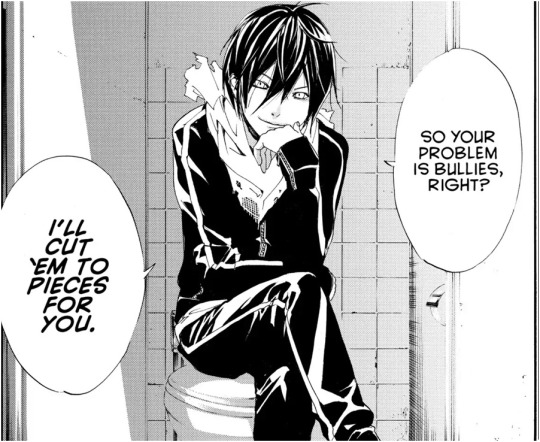
Judging by Tomone’s reaction, she doesn’t take him seriously even when Yato says that slaying is the only thing he’s good at and proceeds to ask Mutsumi to list the people whose heads he needs to take. As far as she knows, Yato keeps saying things like that but actually slays ayakashi, not people. Would he really have killed students to sort a problem like that? Considering that later chapters show him only going after criminals, I think not. It’s just that old habits die hard, I guess.
Chapters 27-28 show in detail what kind of jobs Yato does as a magatsukami. Both of these he gets from Father through Nora. What’s interesting (especially compared to the anime) is that he agreed on the first one on his own – he wanted it to be his last job with Hiiro before stopping to grant these kinds of wishes completely. It’s a prayer from a woman who thinks that her daughter’s murderer’s punishment is not strict enough. Contract killing is a pricy thing, so the woman offers Yato a wad of cash that he refuses to take and only accepts his usual 5 yen.
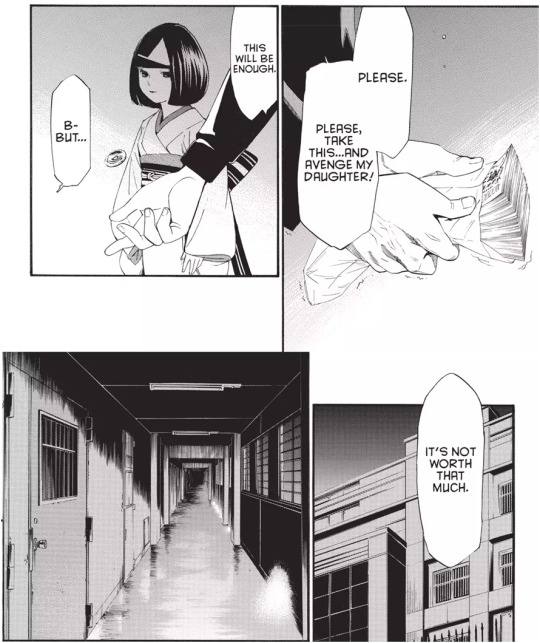
Yato could have taken the entire bundle, which would have solved his financial problems for some time at least. Or he could have chosen any sum other than 5 yen to symbolically detach this job from the requests he takes as a delivery god – but he didn’t. He refuses to accept the whole wad because the life of that criminal has no value to him, but he takes his 5 yen because, for him personally, this wish has the same worth as any other.
The second job is a serial killer who supposedly killed four people and buried them in his garden without ever being caught by the police. This time Yato does not speak with the client directly, so he asks Hiiro if the information is 100% accurate. I personally wouldn’t trust her on that, but apparently Yato finds her words – that the one who’s asked to kill the murderer was his own mother – convincing enough. Except this case turns out to be more difficult that the first. The target has a son, whose mother, according to Hiiro, was the guy’s last victim. Yato decides to go through with the task, but first he locks up the boy in the next room. And again, it’s not clear whether he even gets paid for this job since it turns out that the client is long dead and the second part of her wish was for Yato to find a place where her grandson could live in peace. The difference in Yato’s behavior in this situation and “The clash of the gods of calamity” is significant. He felt no remorse in “The clash...” when he was killing those thugs. Here though, he is hesitant at first, just like with Bishamon’s shinki, because he doesn’t want to leave a child fatherless. He only makes his decision when Hiiro implies that the kid is also in danger. And Yato still tries to at least not traumatize the boy by killing his father right in front of him.
And now we’re at the point which was mentioned in the beginning of this post. In Yomi, Ebisu asks Yato why he exists and Yato replies that his job is necessary because the Heavens fail at doing theirs. There’s evidence to that: just before this exchange Ebisu says it himself, that he’s heard Yato’s name in some oral traditions, and Hiiro earlier called the kind of work Yato does “the Yatogami miracle”. So Yato the god of calamity actually has (or at least had) followers other than Father, it’s delivery god Yato that doesn’t. Father and Hiiro also do anything in their power to persuade Yato that people need his job. Of course, he doesn’t like that he has to be kept prisoner to fulfill his functions. He seemingly only agrees to do what he’s told because it’s the best course of action for him at the moment and goes berserk when he realizes that Hiyori might forget him if he doesn’t go back soon. Nevertheless, Father and Hiiro’s manipulations combined with genuine gratitude from those who need “the Yatogami miracle” have an impact on him, which is evident in his answer to Ebisu.
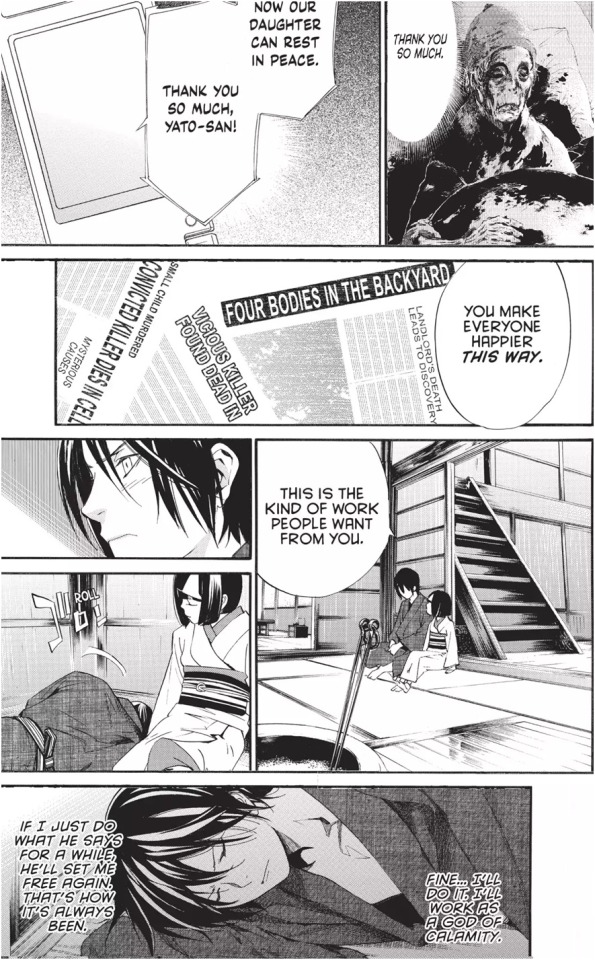
Whether Yato likes it or not, his words about the cracks in Heavenly justice (or more specifically, “the holes in Heaven’s net”, which is supposed to catch all evil-doers) mirror Father’s opinion of the Heavens. Father’s plan to simply kill people and thus diminish the number of those who believe in gods seems to be really flawed to me. So maybe he understood that, too, and chose a different approach. I’ve written earlier that we don’t know if Yato started granting other people’s wishes on Father’s orders or Sakura’s request. But I can imagine that it was part of Father’s plan. Originally Yato was forbidden from even talking to strangers. However, having noticed that he was changing because of Sakura, Father might have started to teach Yato to answer prayers of revenge/restoring justice – to show him how often gods don’t respond to people’s wishes before it’s too late and the only thing that’s left is revenge. Yato may not have given a lot of consideration to that, thinking that he was doing what any god should be doing – answering prayers to continue his existence. But the number of wishes like those only grew, and so the idea that he really was a “necessary evil”, as Father puts it, became more and more ingrained in his mind.
Another important aspect of Yato’s attitude towards his job as a magatsukami is that, in a way, he has an addiction to it. The last time he returned to this field of work he was literally kidnapped and held hostage. But he’s never actively tried leaving Father and Nora before.
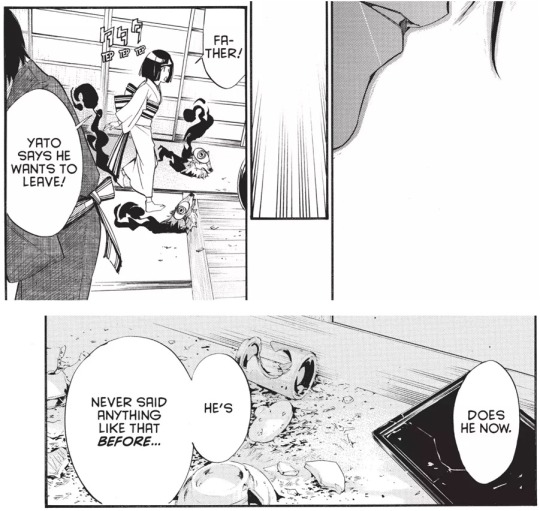
There are multiple reasons why Yato wouldn’t leave until he was told he was free to go. Firstly, he simply didn’t have anywhere to go. Sure, we’ve been shown that his previous shinki weren’t completely unconcerned about him – after all, they would come to Kofuku looking for him. However, since no shinki other than Yukine (except Hiiro) stayed with him for longer than a year, he probably wouldn’t have much commitment towards them. (The official translators actually raised an interesting question in their blog; at least, I never thought much about it before. As we know, it’s established that there are lots of gods who are born from small wishes and don’t exist for long but still manage to name a shinki or two. Kunimi’s first master was like that – he was a doll-like god with his own miniature shrine, born from a game. This wasn’t enough when the children who made him up stopped believing in him. When that god disappeared, the name he gave to Kunimi did not, so as long as Kunimi has a master, he will always be a nora. Here’s the question: how many of Yato’s shinki thought that he simply stopped existing and went looking for another master? Kofuku says that sometimes Yato would go missing for years, so the shinki who got the -Ne name not long before he’d return to Father (you know, the ones that would come to Kofuku) were either eaten by ayakashi or found another master and became forever noras).
Secondly, Father and Nora provided him with food and protection from “wild” ayakashi, so Yato didn’t need to think of places to spend the night. After all, he wasn’t always so lucky as to find a large shrine with a roof like Tenjin’s; sometimes he would sleep besides statues of Buddha.
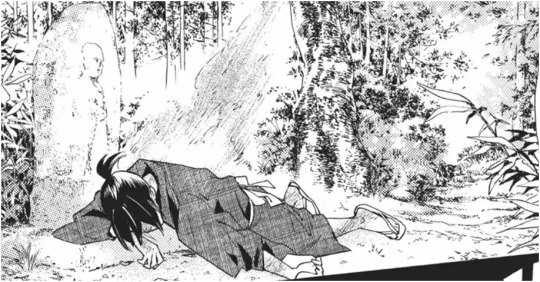
Thirdly, he couldn’t go against his father’s wishes. Even though he’s had other believers (how else his name would appear in those oral traditions Ebisu was talking about?) he is convinced that Father is his lifeline. When Hiyori saw Yato’s reaction to those who commit suicide, she thought he hated them because they throw away the lives that shinki would love to have lived. That is true, but it’s not the only reason. Unlike renowned gods, Yato is in the position of someone who could die any moment. Unlike humans though, he wouldn’t have a second chance as a shinki, or go to the afterworld where he already is – he would simply stop existing and no one would ever remember that he was there. To him there’s no difference between gods who don’t appreciate their immortal lives or suicidal people – from his point of view, they all willingly give up on something that he’s working so hard to gain.

And if he wanted to keep that something, he had to work as a god of calamity.
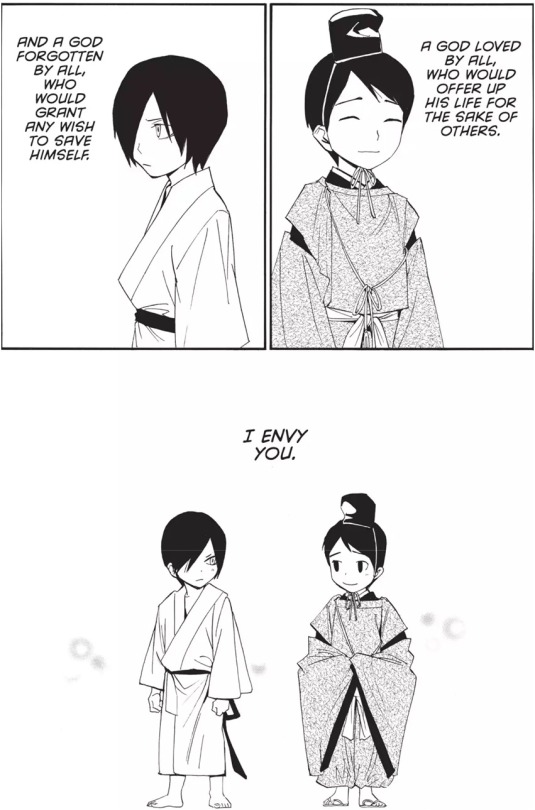
Fourthly, no matter how different Father’s and Sakura’s lessons and approaches were, the one thing Yato’s learnt from them both is that he needs to grant any wish. Not because someone has to do the dirty work when the Heavens are idle, not because they support his existence as a god – it’s something he has to do because it’s the right thing to do. It’s ingrained in his mind. Even the actual plot of Noragami starts when Yato decides to grant Hiyori’s wish, even though she’s never finished her sentence, and takes her 5 yen on his own initiative.
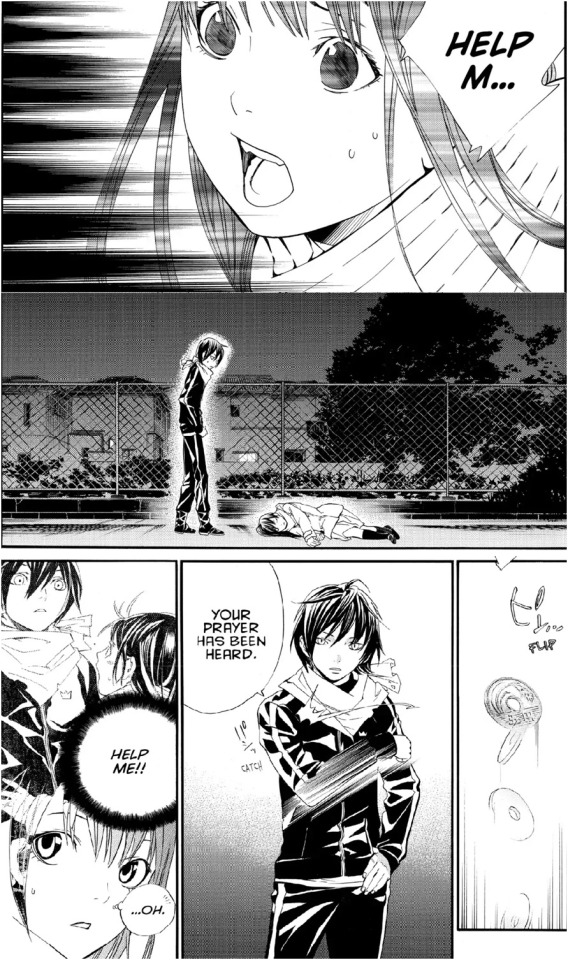
And we also shouldn’t forget that, even though it doesn’t concern him anymore, up to recently Yato still wanted Father’s praise. Father doesn’t say a single nice thing to him now, but that’s not how it’s been before.

On the other hand, Father keeps newspaper clippings of mysterious deaths caused by “the Yatogami miracle” the same way normal parents have keepsakes made by their children. Except that doesn’t make Yato happy at all.
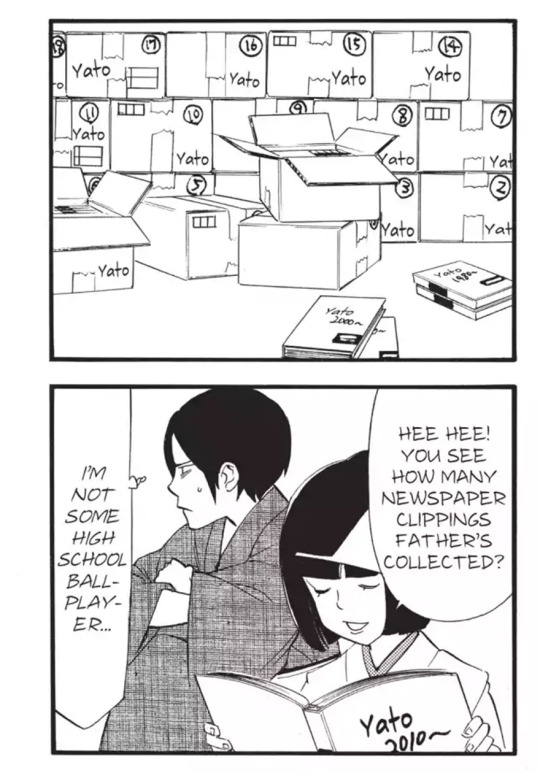
Finally, Yato reveals one more important reason to Yukine after he’s released Nora and decided to become a god of fortune.
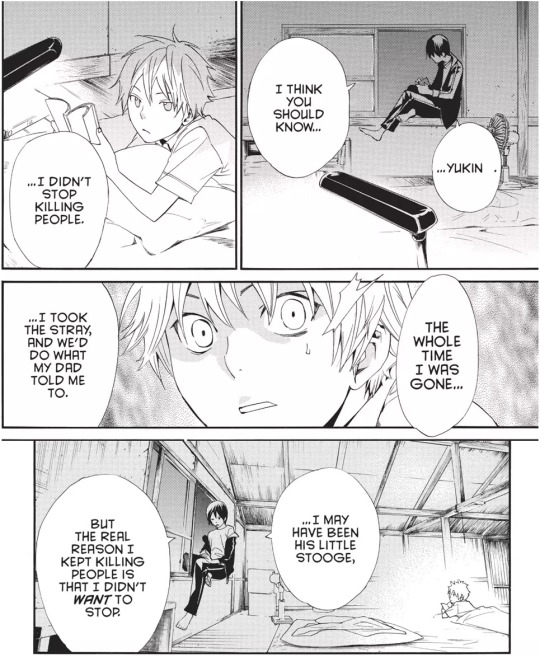
On the surface, Yato seems to be quite full of himself. When he does something impressive or, alternatively, other characters question his competence, he responds with “how long do you think I’ve been a god?” Yet none of the hundreds, maybe even thousands of other jobs he’s done would give him recognition comparable to his work as a god of calamity. Sure, people would sometimes give him beer or food as a tip for his “delivery god” jobs. But Rabo told him that his battle skills could win him glory among samurai. People would offer much larger sums of money for contract killing than for cleaning bathrooms or looking for missing pets, even if Yato wouldn’t take them. The more he killed, the more praise he would get from his Father.
I think this quote from FMA describes his situation perfectly:
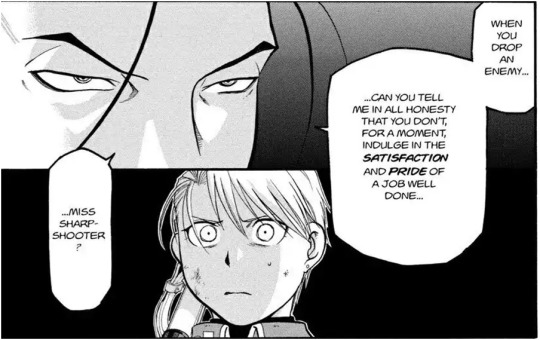
Yato keeps saying that the only thing he’s really good at is slaying. No wander he would want to keep doing something he thinks is his strong side. Getting praise and gratitude from others is important, but every person has the need in self-actualization. His job as a magatsukami has been giving him exactly that – not just the chance to know that hi’s good at what he’s doing, but to see it with his own eyes. Kazuma may not have been too far off course when he said that Yato delighted in atrocities: even when he would occasionally have doubts in what he was doing (like killing Bishamon’s shinki or the serial killer who had a son), some part of him must have felt that satisfaction and pride of a job well done.
In short, Yato’s attitude towards his job as a magatsukami is very ambiguous. It would give him protection from his enemies (ayakashi), food and shelter, the absence of which may not be lethal but is still notable. It would also deprive him of the possibility to have autonomy in his actions, to move around freely and decide anything in his life. It would bind him to Father, the man whose magnificent child rearing methods are the reason Yato’s mental state alternates between that of a thousand-year-old god, a bratty child, or a rebelling teen. It’s also led him to Kazuma, Kofuku and Daikoku and later Ebisu, and each of these encounters has brought something good to his uneasy life. It would always remind him that killing is the only thing he’s good at while showing just how good he is.
Future?
Yato found his will to stop doing the job of a god of calamity when Ebisu showed him that making others happy doesn’t always mean granting others’ wishes. He saw that a god can have their own will, like Ebisu having his own wish to decrease the number of disasters in the human world by controlling ayakashi. He released Hiiro after being unable to do that for a thousand years. Whether he knew that a god doesn’t get to name a shinki they have once released is unknown, but what’s done is done – he will never “play” with Hiiro again.
However, “god of calamity” is not a mere description of his previous functions. A god’s “profession” is also their nature. Kofuku can cause a pandemonium by the sheer force of her aura alone. Ebisu, a god of fortune, is tremendously lucky (well, safe for being falsely accused and executed he is a pretty lucky god). The problem Yato currently faces is that when he was working as a magatsukami he didn’t think twice about how his actions would affect other people. But now he can’t get rid of the thought that even if he isn’t a divine assassin anymore, his nature as a god of calamity hasn’t changed, so he is the reason of all the bad things happening to the people closest to him.
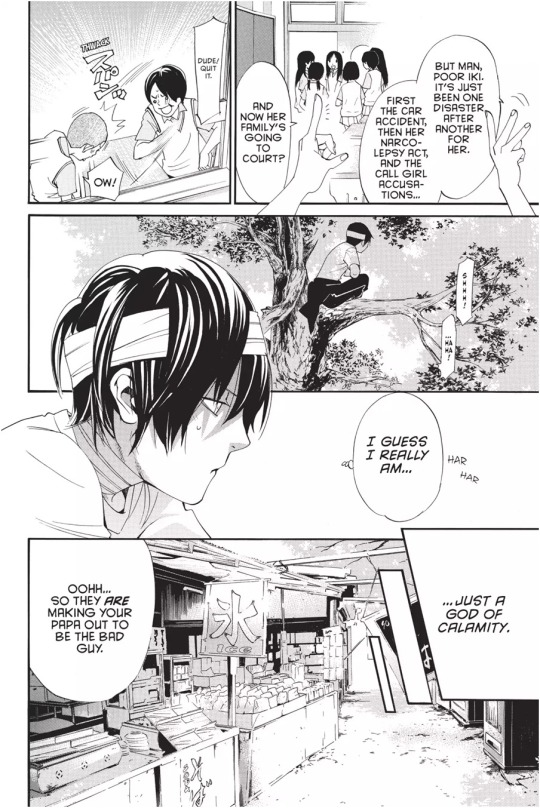
Hiyori says to Yato that he’s been her god of fortune for a while. That’s nice and all, but all the problems that Hiyori’s classmates list have been caused by Yato directly or indirectly. The accident? If Hiyori hadn’t tried to save him from the bus, the accident wouldn’t have happened and she wouldn’t have become a half-ayakashi. The call girl accusations? Yato was the one possessing Hiyori’s body and giving his visit cards to anyone he could find. And the fact that he calls himself a “delivery god” even in original Japanese only exacerbates the matter. In Japan, house calling a prostitute is referred to as “health delivery”, so the reaction to his visit cards is understandable. And though the hospital incident has been staged by Father, he’s done that because he got mad at Hiyori for trying to lead Yaboku astray from his true path of a god of calamity. That’s quite the food for thought. Moreover, even though Yukine and Hiyori go out of their way to make Yato a god of fortune, even though he tries his hardest to achieve that, he can’t get away from being reminded of who he used to be.
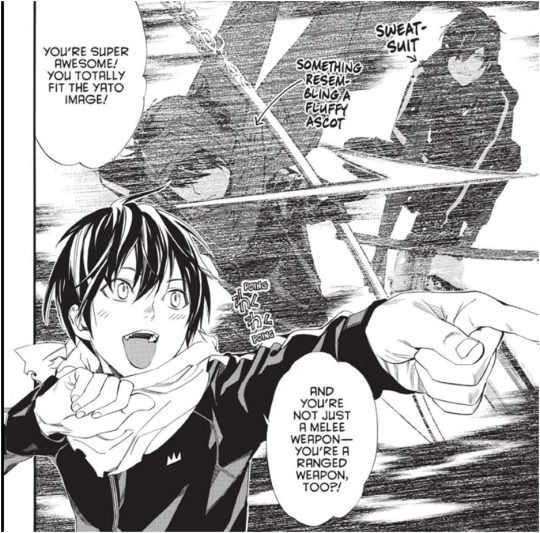

To make Yato a god of fortune, Yukine suggests that he keeps doing what he’s been doing, only with a different goal in mind – slaying ayakashi, not humans, and do all that without being asked. But if his methods haven’t changeв, is there a chance that we’ll still see magatsukami!Yato again? I’m NOT saying that this is how the story will end, because it would completely undermine the message of this series. However, when Bishamon nearly killed Father, it was Yukine who decided to strike her when he saw Yato passing out; it was his hafuri power that sundered the Heavens. But Yato also felt something in that moment– something he hasn’t felt for a long time.
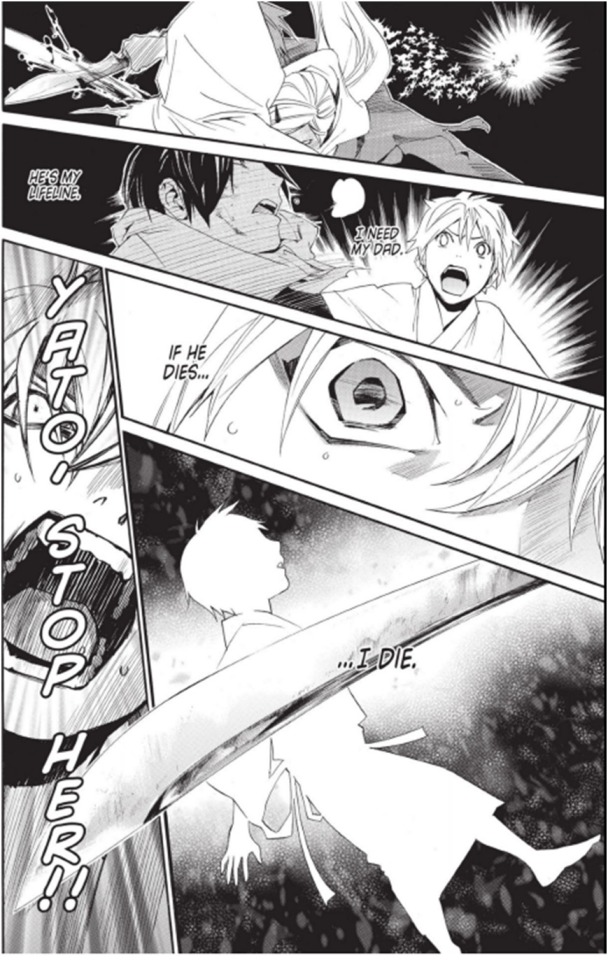
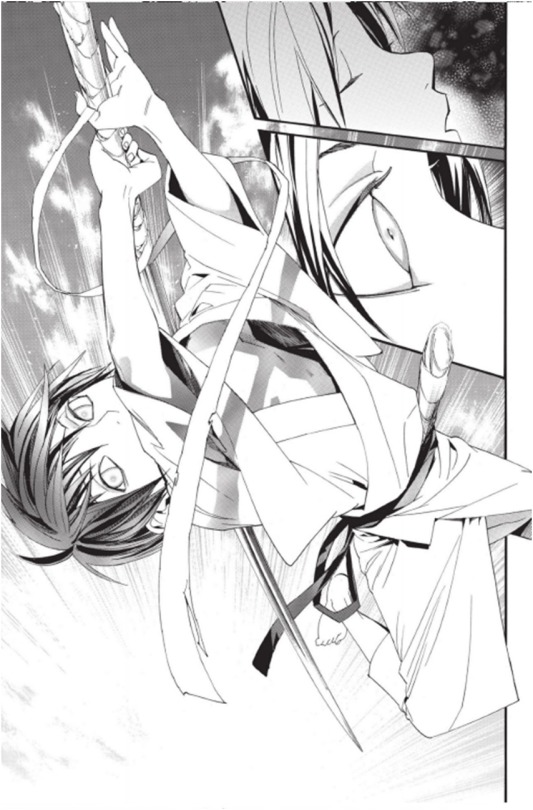
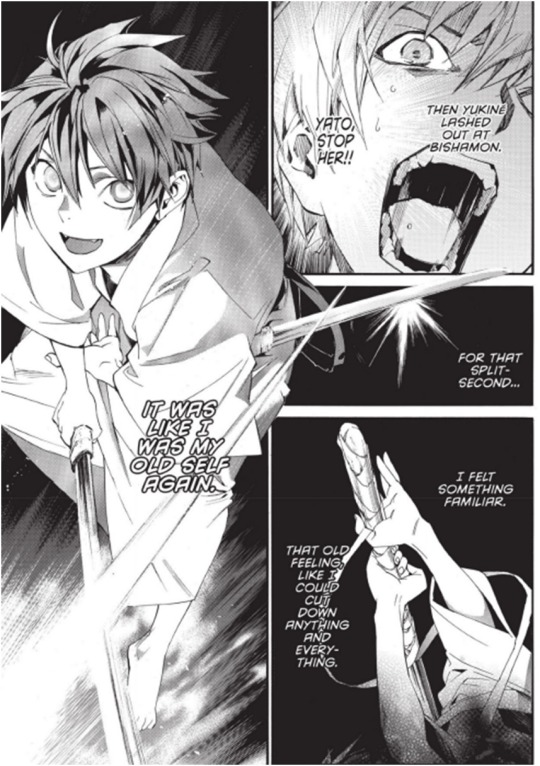
So… who knows?
P.S. if you have a Yato overdose from this post, please don’t blame me
175 notes
·
View notes
Text
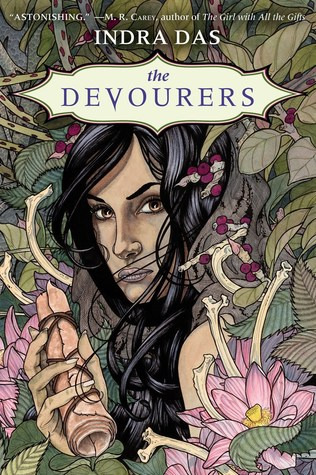
The Devourers. By Indra Das. New York: Del Rey, 2015.
Rating: 4.5/5 stars
Genre: dark fantasy
Part of a Series? No
Summary: On a cool evening in Kolkata, India, beneath a full moon, as the whirling rhythms of traveling musicians fill the night, college professor Alok encounters a mysterious stranger with a bizarre confession and an extraordinary story. Tantalized by the man’s unfinished tale, Alok will do anything to hear its completion. So Alok agrees, at the stranger’s behest, to transcribe a collection of battered notebooks, weathered parchments, and once-living skins.
From these documents spills the chronicle of a race of people at once more than human yet kin to beasts, ruled by instincts and desires blood-deep and ages-old. The tale features a rough wanderer in seventeenth-century Mughal India who finds himself irrevocably drawn to a defiant woman—and destined to be torn asunder by two clashing worlds. With every passing chapter of beauty and brutality, Alok’s interest in the stranger grows and evolves into something darker and more urgent.
***Full review under the cut.***
Content Warnings: rape, gore, violence, sexual content, scatalogical imagery
Overview: I was honestly surprised by how much I loved this book. I went into it expecting a dark fantasy or horror tale, but what I got instead was a visceral, sensual, lyrical meditation on gender, love, humanity, and embodiedness that absolutely refused to let me go once I turned the last page. Some readers, admittedly, may struggle with this - not only is rape an integral part of the plot, but there is a lot of gore and scatalogical imagery that may be off-putting. However, I think these things added to the theme of embodiness, so while some images aren’t pleasant, I think, literarily, they are important. I can’t remember the last time I felt so utterly consumed by a story, and for this reason, I’m giving The Devourers 4.5-5 stars.
Writing: Das’s prose is very descriptive, but I think the author walks the line between being dense and being poetic. I never got the sense that the pace was weighed down by descriptions, and everything was straight-forward enough where I wouldn’t call the prose purple.
I also think Das is a master at using language to evoke strong emotions, whether that be anger, longing, or disgust. Multiple times throughout the novel, I would read a description of dirt or bodily fluids, juxtaposed with an image of ecstasy or loneliness or something else that seemed to contradict the revulsion I felt, and I think such contradictions enhanced the strangeness of the shape-shifter world. To put it more succinctly, this book is gross and primal, but through the gross imagery, it arrives at something more interesting, rather than being gross for shock value.
Plot: This book tells a couple of different stories using Alok’s transcription process and relationship with the stranger as a frame. Thus, there are three fairly distinct threads: Alok’s tale, Fenrir’s tale, and Cyrah’s tale.
Alok’s tale is primarily about alleviating loneliness by finding companionship and learning about the supernatural world. I’ve put it rather bluntly, but it’s more sensual than that. There’s not much that actually happens aside from a series of encounters between Alok and the stranger, but I think these interactions tell the reader a lot about making connections across time and across cultures.
One of the manuscripts that Alok is asked to translate is the brief account of Fenrir’s attraction to Cyrah. Fenrir is the name given to a centuries-old male shapeshifter who has an inexplicable desire to be more human and create life (something that is forbidden among their kind). He finds himself drawn to a human woman named Cyrah, who he rapes and impregnates. What I appreciated about this story was the lack of sympathy it gets from all characters (Alok, Cyrah, Gevaudan, the stranger), so I felt like it was included less as a way to excuse rape and more of a way to understand Fenrir’s motivations. While some may argue we don’t need to understand, I think it ultimately has literary value.
The other manuscript is Cyrah’s account, which made me less angry at the inclusion of Fenrir’s. Cyrah describes her anger at being raped and resolves to confront Fenrir, hoping to make him get rid of the child inside her. To find him, she seeks the help of Gevaudan, Fenrir’s onetime companion. I really loved the story of their journey together and the relationship they formed, which was less romantic and more of a deep, emotional bond that transcended divisions such as predator/prey, shapeshifter/human, and old/young. I also really loved Cyrah’s speeches about how men use women and how Fenrir’s desire to be human is rooted in the basest of human behavior (one might argue it’s even animal behavior). For me, Cyrah’s was the most engaging story of the three, and the most emotionally heart-wrenching, but I could be biased.
Characters: Alok, our primary protagonist (if one could call him that) is a queer man who harbors a deep loneliness following a broken engagement and the lack of family acceptance due to his attraction to men. I really loved Alok’s interest in the stranger and his desire to be close to someone who offered him solace through stories. His longing for more information about the supernatural world mirrored my own interest as a reader, and I think Das did a good job of making Alok relatable enough to serve as the frame but unique enough to not feel like a blank avatar. I also liked how his (their?) exploration with gender at the end mirrored the changing bodies of the shapeshifters.
The stranger, who is mostly nameless, also got more interesting the more I read. At first, he just kind of showed up and spoke in vague puzzles, but the more his story unfolded, the more understandable his mysteriousness became. I liked that Das eventually explained his reasons for choosing Alok and why he withholds information, such as his name; I’m not a huge fan of random mysterious figures, so I appreciated the fact that this character was more than that.
Cyrah is perhaps the most interesting character in that she too provides a frame for the reader. As a human woman, she is also a stranger to the world of the shapeshifters, but she also provides the sole female perspective in the novel. I really liked that she was brave and insistent, not letting men scare her into silence, and I loved the points she made about humanity and gender throughout the book. She also is honest about her feelings about motherhood, which I appreciated, and I think she brings to light several class issues that showcase why it’s not reasonable to expect her to just move on with her life.
My favorite part of this book was Cyrah’s relationship with Gevaudan. Gevaudan is a shapeshifter who considers humans to be solely prey until he gets to know Cyrah (and even then, Cyrah is special - his attitudes as a whole don’t change, but it was interesting to see his relationship with Cyrah evolve). He initially agrees to help her find Fenrir because he wants to reunite with his companion, and he thinks if he is with Cyrah, Fenrir will be less likely to harm him (for reasons explained in the novel). Gevaudan’s emotional relationship with Fenrir is incredibly complicated and queer, and I liked that there was so much tension between the three characters in terms of who had relationships with who. I loved that Gevaudan’s feelings for Cyrah are never portrayed as romantic, but something deeper than friendship that challenges a lot of the beliefs he has about whether or not his kind can feel love.
Fenrir, despite being a rapist, is also interesting for his flawed idea of what humanity means. Although I hated that he raped Cyrah, I appreciated the role he had in the novel and the way he brought out Cyrah’s indignation. I also liked the relationship he had with Gevaudan and the contrast he provided, which prompted questions about the nature of monstrosity.
TL;DR: Told through multiple perspectives using evocative (and often revolting) imagery, The Devourers is a stunning debut of a novel that interrogates the nature of monstrosity and identity, using shapeshifters to challenge (hetero?) normative states of embodiedness, sexuality, and gender.
3 notes
·
View notes
Text
Hey! I want to talk a moment about something. This is a character, so if you don't like this opinion, just ignore it!
Ok, I want to throw this note right away. I want to talk about Tinker. It's not a good thing about her, so you can ignore this.
My big point of view is this. I don't think Tinker has been planned as Eve.
And before you tell me that by her name she fits the mother, please stop. That is a poor excuse, and nothing elaborate.
So leaving the subject of the name aside, I go to the following.
A long time ago a mangaka said: Before creating a good character, create his story, his character, his weaknesses, his virtues. The approach you will have with the story and the other characters. When you have all that elaborated. Only there can you assign a gender. If this character will be male or female. "
Tanaka has given us sketches of the characters, which is admirable. We have the opportunity to see what other designs our favorite characters had. But with giving us these sketches, do you really believe that all the sketches were planned from the beginning of the story?
Tanaka changed designs over the course of the story. We are not blind. We have all seen the change of Illio, an example. Then we can say that Tanaka, as she advances or builds her story, is changing things.
And that's where I want to focus. Tinker was not planned. At least, not from the beginning. In fact, not even since the beginning of the story in C3. (As some people are saying)
Let's think for a moment. Since when did they tell us about her? Chapter 13. It was his first appearance. From the beginning the character was included as a secondary one. And it went on until the contract.
So tell me, where was she planned? From chapter 13? Or after her contract?
People say their name joins Wrath. Because supposedly it is virtue. But do you really think so?
The name does not make sense to me because of the following. Tanaka was able to create his name a day before, and you wouldn't realize it. And that's because they never gave us a name, it was always Tinker (or Yosetsu). Then the mangaka made a bad play. If the reason for never giving us a name was because she would be an eve, and Tanaka wanted to make a good impression. He did it wrong. Very very bad.
And do you know why? Because Tinker's story has no more than two chapters. If Tanaka planned to surprise us with this character, don't they think the approach they gave her is quite poor? You as Tinker fans, don't you feel disappointed because your supposed female character only had at most, five important chapters? (Remember character that appeared in chapter 13)
Your female character, planned from the beginning of the story, never went through training. He never crossed two lines of words with the other Eves, He was never interested in stopping Tsubaki (Think about that) Nor did he want to make an effort to stop Shuuhei. All that was planned from the beginning? So you tell me?
Tanaka spent five years planning that. It is wonderful! So long have his been planning to give us this surprise? It's great! (This is sarcasm)
Let's make a point of comparison. Tinker is the newest among the Eves.
Tinker has no idea how to fight. Otherwise he wouldn't have asked Wrath for a contract to stop a vampire.
But ironically she can drive a Lead.
He has a contract made just five minutes ago. Are you telling me that she trained since childhood to control a Lead? No! Not only that. She also knows how to use combined attacks with Wrath!
That's absurd. Misono, Mikuni, Licht, Mahiru, and even Nicco, have been living with their Servamp for more than a few months (some have spent years), and they all had to train. Mahiru is the protagonist, so Tanaka could show us with him, how he lives with your Servamp. With Mahiru we could see how difficult it is to manipulate the Servamp when it comes to fighting. Especially if the contract is recent.
Because it's not about making a contract and that's it, I have my biological weapon. No! Here the feelings and determination of Eve are combined.
Are you telling me that Izuna could do all that in a few minutes? That all that happened to her was planned from the beginning? Don't you think there is something strange here? You don't have to be very smart to realize that the Izuna character was manipulated. Yes. Manipulated. Because he danced with Inner Wrath and magically dominated the "Wrath." Here the power of the script needed her to be strong. That is character manipulation, or the well-known, Power up.
Now you tell me, she is strong and pretty. He managed to save his friend from revenge.
I think we were all surprised at how quickly the issue of Shuuhei and Shamrock was resolved. It was a revenge. There was so much hatred and resentment in Shuuhei's heart that it seemed a mockery what they did with him.
Izuna is an expert in stopping revenge. That showed us the chapter. Don't you think Tell me why she hasn't gone to stop Tsubaki? She knows that revenge is bad, so shouldn't she talk to Tsubaki? She works wonders! It is a goddess that stops everything! Izuna is the key to stop Tsubaki! (All this is sarcasm)
Are you telling me with your character planned from the beginning?
If from the beginning she was planned as Eve. Why did Tanaka fix Shuuhei's confrontation in just one chapter? We had more than 60 chapters with his revenge, and in the end everything ended just because Tinker fainted from the fight? Tanaka planned all that from the beginning?
I'm sorry if I'm tough on this issue, but I can't help laughing when people say "from the beginning it was planned as Eve, because her name fits with Wrath's"
You know, you can go to Wikipedia and look for the names and yes, you will get stories. But that does not justify that Tinker has been planned. A name says nothing if the story from the beginning did not give you a chance to progress as a character.
If you are going to talk to me about names that fit and have stories. Guys, there was another name before it matched Wrath's. And that was Tsurugi. Tsurugi's code name is Baldr, and in mythology, Baldr is Frigg's son. Do you know what that meant? Tanaka built the character of Tsurugi from the beginning, and throughout the course of C3 and with the end, they told us that Tsurugi what he needed most was a mother figure in his life.
(If I have to give a theory of characters that were planned from the beginning, it is certainly Tsurugi. In addition, we can even say that Tanaka is fond of these two. Tsurugi is one of his most popular characters, and for his birthday , he drew it even with Wrath. So you can't tell me they both have no connection.)
Izuna nobel means nothing. Because, as I said, Tanaka could create that name just when she drew the chapter. You imagine? Tanaka saying: I need a name that is related to Freya or Frigg, aah Idun! "And Ready, there you have your female character that was planned from the beginning. LOL
A curiosity that I found with his name, from the beginning on the Tanaka Strike web page, Tinker's name was set as "Yosetsu" There were people who thought that was his name, but then changed to Izuna.
How strange, right? Tanaka really planned it from the beginning?
I wanted to make this note because it seems absurd for people to say it was planned. The people who only watched the anime, the first thing they did was to ask themselves: “And the women?” Tanaka focused too much on the story of C3 and it seemed that it would never end.
The strongest theory was that they pressured Tanaka to create a female character. Whether her fans asked for it or the publishers. What we do know is that Tinker gained strength at a time where it was not needed.
We didn't need revenge and the whole story of Shuuhei will end in C3. And much less that it ended like this!! It makes Shuuhei look like a spoiled child. Just put yourself in his place. Someone murdered your father. That someone is a family friend! Would you forgive him? They took your father away when you were only 8 years old, they left you and your sister alone! And your mother was a widow! That leaves a scar too deep.
Tinker from the beginning, and if she really wanted to, she could help her friend.
Don't you realize that she hasn't done anything? He told the story of Shuuhei to Mahiru because she expected Mahi to do something. Then he asked Wrath for help fighting. She doesn't know how to fight? She doesn't know how to use her weapons? Don't you think it would have been more epic to see her use her own weapons and defend her friend? Instead of relying on a Servamp.
People who protect her just because she is the female Eve are wrong (ok, are they her tastes, but really?) A character is good when her story is good. When it is well designed. When it seems that mangaka really worked on the character.
But, Tinker looks like it was only created to satisfy fans. You have to accept that before being an eve, I didn't have a fan group. There were very few people who really noticed her. Her story is so basic that it leaves you wondering, what does she do there? She did not cause much impact. She is quite normal.
What makes her special is only because she is a woman. (Everyone defends her because she is the great female Eve of the group)
People forgot Ophelia? Ophelia is a great character. Her story was short but she did have a great impact, not only because she was a princess in a world at war, but because she did have a well-crafted story. She was the fundamental pillar in the madness that Lawless developed. Do you understand that She had a motive, a purpose to appear in the story.
Tinker, what was his motive? Save her friend? That sounds good, but was a contract necessary? Was it necessary to make Eve so forced into history? You can protect her, but ask yourself this; Would you love her if it wasn't an eve?
If Tanaka had made her alone, with her own hands, help her friend. Would you love her? For my part, I would say yes. Because she would be the first human (no contract. Without a servamp) who would face a vampire to protect her friend. That would have looked more natural. More fluid in the sleeve. Something more realistic. And definitely something epic ...
But instead, what did they do? They made her look like a true useless. He makes weapons and is not able to use them to protect his friend. (So, reallly?) He starts to cry in the middle of the disaster to beg a Servamp contract. And he's so selfish, he asked Wrath for help, leaving all the other characters aside. Recall that Mahiru was missing, and she knew, but did she care? No.( They were all facing Touma, and she just wanted to vent her own guilt. That seems stupid, and even more so if her can't do it without help.)
She is selfish because Wrath was locked in C3 for several days but Tinker never bothered to help her, or ask for help before. She only did it when she was more desperate and realized that she is insignificant. Because he never bothered to train to use his weapons. Because he never bothered to really help his friend. She let Shuuhei advance her revenge.
When you look at it from that point. Do you think that she really is her best friend? Someone who lets you lose yourself in madness is definitely not. And don't talk to me about the end, because that ending doesn't make any sense.
We all know that Tanaka got bored and gave him that hurried end. Shuuhei's revenge was able to postpone it for another arc. But seeing how Tanaka is carrying things, we already know it was impossible. Tanaka is not doing things right. We all realize that she is moving very fast in her sleeve. And that happens because it creates too many characters and everyone should get a story.
The only reason why Tinker is Eve is because the Fans wanted a woman, and because Wrath needed a name before losing the fight against Tsubaki. Which was disappointing.
So that's my point. A character that nobody talked about, not even mangaka, from one chapter to another becomes important. Does it make you think it was always planned? Or do you just defend it because there are no more women in the manga, and in today's world feminism is in fashion? (I don't want to get into controversy with this)
I said what I think because I feel and I think I have the right to say what I don't like about a character. In this fandom we cannot say "I hate Izuna, I hate Sakuya" because they immediately attack you with anonymous messages.
I said this because many people think alike but are afraid to speak it. I did not make this note to unleash hate, on the contrary, I said what many people think, is everything.
If my words bother you, it's because you know I'm really right. Which gives me a point for me. Yey~
47 notes
·
View notes
Note
Your Top Five Pulp Heroes that you wish were better known? By Pulp Hero fans, I mean. Since pretty much all of them except Conan and Tarzan are fairly unknown.
It’s actually quite hard for me to narrow it down to just five, because I’m having to choose between characters that are my favorites that I wish were more well-known and appreciated (which is all of them), and characters that aren’t quite my favorites but I very much think should have achieved great popularity for a myriad of reasons. So instead I’m going to pick some of each. These are not necessarily ranked by their importance or my personal taste, just 5 characters I felt like highlighting in particular.
Honorable mentions goes to characters I already talked about prior and don’t want to repeat myself on. These aren’t “lesser” picks, just ones that I already talked about: Imaro (who in particular definitely feels like he could, and should be, a pop culture superstar if he was only more well-known), Kapitan Mors (who’s got a lot in common with one of my favorite fictional characters, Captain Nemo, but also has a lot of interesting things going on for him as his own character). Sar Dubnotal (a character that appeals a lot to me and I think should be included much more often in pulp hero team-ups). The Golden Amazon (again, definitely a character that feels like it’s just begging to have a pop culture breakout, even comic books rarely if ever have female supervillains this ruthless and over-the-top), The Mexican Fantomas (who absolutely deserves a better name than what I’m calling him here, because he’s incredibly awesome and leagues ahead of just being a knock-off). And of course my homeboy, The Grey Claw, whom I would consider Number One of the list if it wasn’t for the fact that his obscurity has left him untouched by copyright and I got plans of my own for the character that wouldn’t be possible if he was more well-known, so I guess I’m ultimately glad he’s obscure (even if I’m still bothered by how little he’s known).
Allright let’s go:
Number 5: Sheridan Doome
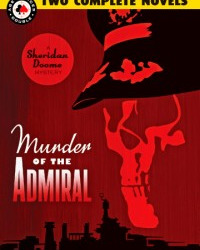
Sheridan Doome appeared in fifty-four stories and three novels from 1935 to 1943. As chief detective for U.S. Naval Intelligence, Lieutenant Commander Sheridan Doome’s job was a grim one. Whenever an extraordinary mystery or crime occurred in the fleet, on a naval base, or anywhere the navy worked to protect American interests, Doome was immediately dispatched to investigate it. Fear and dread would always precede Doome’s arrival in his special black airplane. For, in an explosion during WWI, he had been monstrously disfigured.
He was six feet two inches tall; had a chalk-white face and head. It appeared as though it had once been seared or burned. For eyes, he had only black blotches; glittering optics, that looked like small chunks of coal. His nose was long, the end of it squared off rudely. He had no lips, just a slit that was his mouth. His neck was long, as white and as bony as his face…. Sheridan Doome looked more like a robot than a human being. He was tall and ghastly; his uniform fitted him in a loose manner. Long arms hung at his sides; his face was a perfect blank. He had no control of his facial muscles; consequently, his countenance was always without expression, chalky and bony.
But behind the ugliness was a brilliant mind. Sheridan Doome always got his man. Before Sheridan Doome became a staple in the pages of The Shadow magazine, two Doome hardcover mysteries were written in the mid-1930’s by acclaimed hard-boiled author Steve Fisher (I Wake Up Screaming) and edited by his wife Edythe Seims (Dime Detective, G-8 and His Battle Aces). Age of Aces now brings you both books in one huge double novel, presented in a retro “flip book” style. This book is currently Out of Print.
I sadly don’t have any more information on the character other than this. The book is unavailable for me to acquire in any capacity, and the text above is taken from the Age of Aces website as well as Jess Nevins’s personal profile for the character. I’m not even sure if any of those 54 stories even exist anymore, since although he was published as a backup in Shadow Magazine, there doesn’t seem to be reprints of them anywhere, at least as far as I can find, and the original Shadow magazines have largely turned to dust by now.
A character who combines aspects of The Phantom of the Opera and The Shadow, whose adventures are set in a backdrop that can easily lead to ocean adventures? That’s like, what, three of my favorite things in the world combined. I really, really wish I could at least read the stories this character stars in, but as is, this description is all I can provide. Again, time really has been cruel to the pulp heroes.
Number 4: Harlan Dyce

This is another character I’ve only been able to learn about through Jess Nevins’s archives and have not been able to attain any further information on, which is sadly the case with a lot of pulp heroes that nowadays only seem to exist as footnotes in his Encyclopedia or records in libraries. I don’t post more about these characters because I really would just be copying the stuff he wrote without much to justify me quoting him verbatim, and I hate the idea of doing that.
I especially hate that in Harlan Dyce’s case though. Here’s his description
“Dyce had brains, taste, money, ambition, and a total lack of physical or spiritual fear. But—
“Dyce was thirty-three inches tall and weighed sixty pounds.
“That was all the world could ever hold against him. That was what had made the world, most of it, in all the countries of the world, stare at Harlan Dyce, billed in the big show as “General Midge.””
Harlan Dyce is a misanthropic and venomous private detective. He has an “amazingly handsome face,” and the aforementioned brains. But all anyone sees is his stature, and he hates that and turns his cold eyes and acid tongue on them.
The only person Dyce likes and gets along with (besides his dwarf wife, a former client) is his assistant, Nick Melchem, a six-foot tall former p.i.’s assistant with bleak eyes and a strong body. Melchem ignores Dyce’s stature and treats Dyce normally, which Dyce responds warmly to.
Dwarfs may be the single most maligned group of people depicted in pulp magazines, even more so than the Japanese in the war years or the Chinese during the peak of the Yellow Peril’s popularity. Evil dwarfs, murderous dwarfs, sexually depraved dwarfs, they are all loathsome, ugly cliches that are, sadly, the only instances you see of dwarf characters being represented at all, with the only ones who are awarded any measure of sympathy are doomed henchmen or tragic villains. Even outside of the pulps, the only other examples of heroic, protagonist dwarfs I can think off the top of my head are Puck from Marvel Comics and Tyrion Lannister from Game of Thrones.
I’m not gonna say Harlan Dyce is great representation because I’m not a little person and can never make that kind of claim for a group I’m not a part of, but Harlan Dyce may be the first time I’ve ever seen a dwarf character in pulp fiction who was not a villain or a murderous goon or a victim, but an actual person and a heroic protagonist, and that definitely counts for something. I’m not sure how popular this character was or could be if someone picked up the concept and ran with it (and I’m pretty sure he’s public domain), but I definitely think this is a character that should exist and should be popular.
Hell, this character has Peter Dinklage written all over it, give it to him. Maybe then he will get to play a smart, fearless, cynical, misanthropic but good-natured and heroic character in something where he actually gets to keep these traits until the show ends.
Number 3: Audaz, O Demolidor

Audaz is a Brazilian character who was created and published by Gazetinha, the same publishers of Grey Claw as well as properties exported from elsewhere like Superman and Popeye, and much like The Grey Claw, he is also completely unknown even here. I’ll get to Audaz more in-depth sometime but here I’m going to provide a quick summary:
Audaz, The Demolisher is a gigantic crime-fighting robot controlled and piloted by the brilliant scientist Dr. Blum, his close friend Gregor and the child prodigy Jacques Ennes, who pilot the giant robot from a massive laboratory inside it's head rather than a cockpit. He takes on a variety of ordinary human criminals, mad scientists, supervillains and invading armies, towering over skyscrapers and grappling with jets.
Audaz was created in 1939 by illustrator Messias de Melo, a year before Quality Comics's Bozo the Iron Man and 5 years before Ryuichi Yokoyama's Kagaku Senshi, and decades before the debut of Mazinger Z. Although he is not the first giant robot of science fiction, he is the first heroic giant robot piloted by human pilots, and thus the first true example of "mecha" fiction.
Number 2: Emilia the Ragdoll

This is another Brazilian character, although nowhere near as obscure as Audaz as even a cursory Google search can show. Although Brazil did not have a “pulp era” in the same way the US had, we’ve long gotten past the point of sticking to it as a definitive rule, and I’m including Emilia as a pulp hero because she’s a 1920s fantasy literature character who was created under a publishing company that released pulp stories, because she doesn’t quite belong in the mold of fantasy literature characters she takes after, and because I like her and if I was putting a bunch of pulp heroes together in the same story, I would definitely include Emilia in it. It’s not like she really has anywhere else to go, now that she’s public domain and she’s outlasted her franchise.
As you can tell by the above image, Emilia’s had a lot of variations over the years and that’s because the work she was created for, Sítio do Picapau Amarelo (Yellow Woodpecker Ranch/Farm), has become a major bedrock of Brazilian fantasy literature, one of the only works created here that you can find substantial information about in English if you go looking for it. Here’s some descriptions of Emilia’s character:
Emília is a rag doll described as "clumsy" or "ugly", resembling a "witch" that was handmade by Aunt Nastácia, the ranch's cook, for the little girl Lúcia, out of an old skirt. After Lucia takes her on an adventure and the doll is given a dose of magic pills, Emília suddenly started talking, and would never stop henceforth.
Emilia has a rough, antagonistic personality, and an independent, free-spirited and anarchist behaviour. She is rogue, rebellious, stubborn, rough and intensely determined at anything she sets her mind on, eager to take off on just about any adventure. She is often immature and behaves like a curious and arrogant child, always wanting to be the center of attention.
She is extremely opinionated even when she constantly and confidently mispronounces words and expressions. Her attitude often gets her into trouble, and she very often has to fight against the villains who attack her home on the Yellow Woodpecker Farm and mistreat her friends.
In the stories, Emilia often takes the role of a heroine who travels through different realms and dimensions, as the books include not only figures from Brazilian and worldwide folklore, but also several characters both real and fictional, such as Hercules, King Arthur, Don Quixote, Thumbelina, Da Vinci, Shirley Temple, Captain Hook, Santos Dumont and Baron von Munchausen.
She's fought scorpions and martians and nymph hordes, her arch-enemy is an alligator witch, she rescued an angel from the Milky Way and tried to teach it how to become a human, and once shrunk the entire population of Earth to try and talk the president of the United States into ending war forever.
To little surprise, she has become the most popular character and the series’s mascot.
It’s a little strange to consider Emilia underrated considering she is one of the most famous original characters of Brazilian literature, but hardly anyone outside of Brazil even knows who she is, and regardless of the quality of the original stories (and Monteiro Lobato’s views on race that tar much of his reputation), Emilia definitely feels to me like a character that should be a lot more popular globally.
She is the only character from Yellow Woodpecker Ranch that has transcended the original stories, since she was always the most popular character and there’s been a couple of stories written about her that usually separate her from the ranch and just set her out on the world by herself. The latest story about this character has been a series called The Return of Emilia, that’s about her stepping out of the books in 2050 and discovering a Brazil that’s been ruined by social and ecological devastation, and traveling back in time via a flying scooter in order to try and prevent this calamity.
Now that she’s public domain, I definitely think there’s some great stories that can be told with the character that just about anyone could get to, and I definitely think she’s a character that deserves more appreciation. Anything goes in stories starring her and it’s that kind of free-for-all freedom that I think can benefit future takes on pulp heroes. I would be very happy to place Emilia among them.
Oh yeah, and there was one time she kicked Popeye's ass by tricking him with a can of mouldy cabbage instead of spinach, making him sick and then beating him, which possibly puts her as one of the all-time badasses of fiction, except she would be pissed at not being number one and likely embark on a quest to beat everyone else just to prove she could, because that’s how Emilia rolls.
Number 1: Luna Bartendale, from The Undying Monster (1922)

Not necessarily my favorite of the bunch, but one who sort of epitomizes what you asked, a character who is both incredibly obscure and incredibly underrated in every sense. Despite the book being somewhat known, mainly thanks to the movie, the character is so obscure that I don’t even have an illustration of her to display here, not even fan art, just one of the book’s covers that I think best conveys it. Luckily, the book is also available freely online, so you can all go check it out here. The movie adaptation does not feature the character of Luna Bartendale which makes it pointless to talk about.
To not spoil it too much, The Undying Monster is a very fascinating book, ahead of it’s time in quite a few ways. You expect it to just be a detective story centered around a werewolf cursed, except the subtitle of the book is “The Fifth Dimension” and then it goes to talk about dimensions of thought and post-WWI trauma and love and hypnotic regression that travels through time and ancient runes and Norse mythology. It’s not exactly an easy book to get through in one setting, but I’d recommend it much the same if only because it’s got supersensitive psychic sleuth Luna Bartendale, literature’s first female occult detective, and she’s an incredible character who absolutely feels like she should have become a literary icon.
She lives in London but is world-renowned for her many good deeds. She is a small, pretty woman, with curly blonde hair, dark eyebrows and a high-bridged nose, and a slight build. She has a voice described as a light soprano that "does not make much noise but carries a long way".
Petite, bedimpled and golden curled, Luna is completely in charge of events, dominating every scene that she appears in with her welcoming disposition and cleverness.
Bartendale has various psychic powers, including mind reading. She is well-versed in psychic and occult lore, is a “supersensitive” psychic, and has a “Sixth Sense” which allows her to trace things and people through both the Fourth and the Fifth Dimension. (The Fifth Dimension is “the Dimension that surrounds and pervades the Fourth–known as the Supernatural”).
Her extensive knowledge of occult rites and practices puts John Silence, Carnacki and Miles Pennoyer to shame, and she beats them all with her "super-sensitive" gift of being able to psychically connect with troubled souls and hypnotize them.
She uses a divining rod for various tasks, including psychic detection and tracking, and distinguishing between benevolent and malevolent forces. She has various (undefined) powerful psychic defenses, can carry on seances, and can even cure a person of “wehrwolfism.” And she can always rely on her massive, intelligent dog Roska for help.
Luna sadly doesn’t show up in the book as often as I’d hoped, but everything about this character is so delightful. In a lot od ways she hardly feels like a pulp hero, at least the ones I usually talk about. She feels like a lost protagonist from an incredibly successful kid’s adventure series where a kind and eccentric detective witch and her giant dog go around solving occult mysteries and encountering all sorts of weird supernatural beings while counseling and helping people, like Ms Frizzle meets Hilda. Like this character is just waiting for Cartoon Saloon to make a film about her.
Its not so much “this character should/could be popular but it’s clear why that didn’t pan out”, it’s more me being confused as “why the hell isn’t she super popular? This character should have had a franchise ages ago, holy shit put her in everything””
42 notes
·
View notes